Überarbeitungen: 2011-03-06 [Ergänzungen]
©opyright: Creative Commons Lizenz (Namensnennung, keine kommerzielle Nutzung, share alike)
|
Meinem Lehrer und Freund Prof. Dr. Heinrich von Stietencron ist die gesamte Amarakośa-Übersetzung in Dankbarkeit gewidmet. |
|
Meiner lieben Frau Margarete Payer die all meine Interessen teilt und fördert ist das Tierkapitel in Dankbarkeit besonders gewidmet |
Falls Sie die diakritischen Zeichen nicht dargestellt bekommen, installieren Sie eine Schrift mit Diakritika wie z.B. Tahoma.
"Those who have never considered the subject are little aware how much the appearance and habit of a plant become altered by the influence of its position. It requires much observation to speak authoritatively on the distinction in point of stature between many trees and shrubs. Shrubs in the low country, small and stunted in growth, become handsome and goodly trees on higher lands, and to an inexperienced eye they appear to be different plants. The Jatropha curcas grows to a tree some 15 or 20 feet on the Neilgherries, while the Datura alba is three or four times the size in>n the hills that it is on the plains. It is therefore with much diffidence that I have occasionally presumed to insert the height of a tree or shrub. The same remark may be applied to flowers and the flowering seasons, especially the latter. I have seen the Lagerstroemia Reginae, whose proper time of flowering is March and April, previous to the commencement of the rains, in blossom more or less all the year in gardens in Travancore. I have endeavoured to give the real or natural flowering seasons, in contradistinction to the chance ones, but, I am afraid, with little success; and it should be recollected that to aim at precision in such a part of the description of plants is almost hopeless, without that prolonged study of their local habits for which a lifetime would scarcely suffice."
[Quelle: Drury, Heber <1819 - 1872>: The useful plants of India : with notices of their chief value in commerce, medicine, and the arts. -- 2d ed. with additions and corrections. London : Allen, 1873. -- xvi, 512 p. ; 22 cm. -- S. VIII f.]
2. dvitīyaṃ kāṇḍam - Zweiter Teil
2.9. siṃhādivargaḥ - Abschnitt über Löwen und andere Tiere
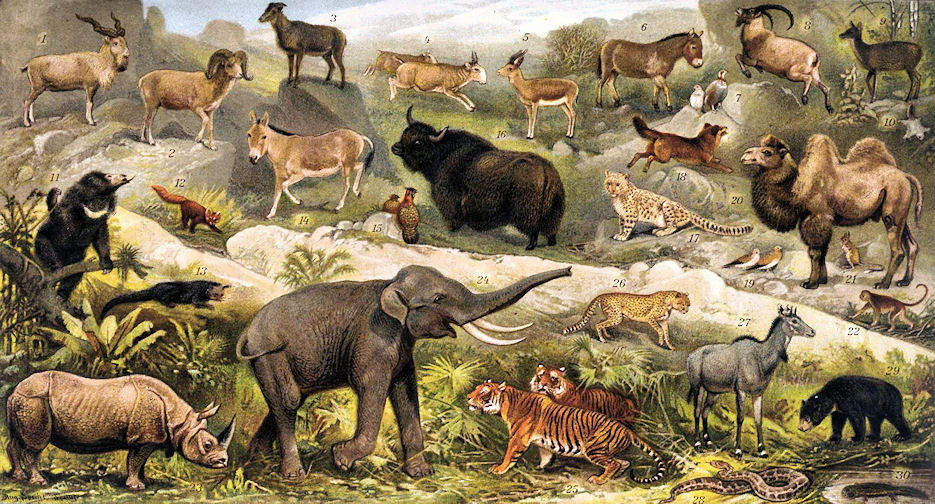
Abb.: Asiatische Tierwelt
[Bildquelle: Brockhaus' Kleines Konversationslexikon, 1906]
Referenzwerke:
Mammal species of the world : a taxonomic and geographic reference / ed. by Don E. Wilson and DeeAnn M. Reeder. -- 3. ed. -- Baltimore : John Hopkins Univ. Pr., 2005. -- 2 Bde. : 2142 S. -- ISBN 0-8o18-8221-4 [Normierend für lateinische und englische Säugetiernamen]
Menon, Vivek: Mammals of India. -- New Jersey : Princeton UP, ©2009. -- 201 S. : Ill. -- ISBN 978-0-691-14067-4 [Sehr gute Übersicht über die wichtigsten Säugetiere Indiens]
Walker's mammals of the world / Ronald M. Nowak; John L. Paradiso. - Baltimore, Md. [u.a.] : Johns Hopkins Univ. Pr., 1999. -- 2 Bde. -- ISBN 0-8018-3970-X [Referenzwerk für Säugetiere]
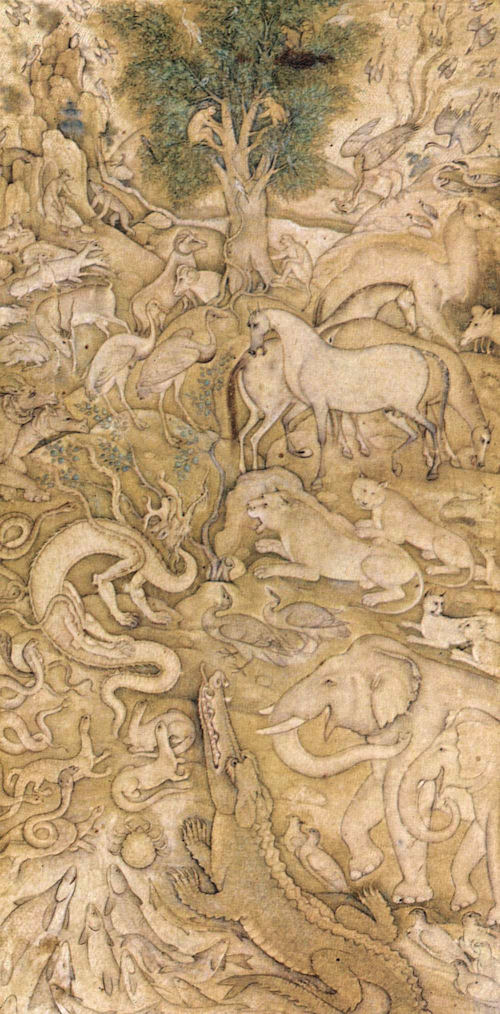
Abb.: Die Welt der Tiere, Mogul-Schule, 1600/25
Übersicht
- 2.9.1. Panthera leo persica Meyer, 1826 -
Asiatischer Löwe - Asiatic Lion
- 2.9.1.1. Löwe als vāhana
- 2.9.1.2. Narasiṃha
- 2.9.1.3. Aśoka's Löwenkapitell
- 2.9.2.
Panthera tigris tigris Linnaeus, 1758 - Königstiger - Bengal Tiger
- 2.9.2.1. Tiger als vāhana
- 2.9.2.2. Tiger als Wandschmuck (Gefahrenabwehr?)
- 2.9.3. Hyaena hyaena Linnaeus, 1758 - Streifenhyäne - Striped Hyena
- 2.9.4. Sus scrofa
cristatus Wagner, 1839 - Wildschwein - Wild
Boar
- 2.9.4.1. Varāha-Avatāra
- 2.9.4.2. Varāhī - eine Mātṛkā
- 2.9.5. Affen
- 2.9.5.1. Makaken
- 2.9.5.2. Semnopithecus entellus Dufresne, 1797 - Hanuman-Langur -
Northern Plains Gray Langur (Hanuman Langur)
- 2.9.5.2.1. Hanumān, der göttliche Affe
- 2.9.5.3. Haubenlanguren
- 2.9.5.4. Bunopithecus hoolock Harlan, 1834 - Weißbrauen-Gibbon / Hulock - Hoolock Gibbon
- 2.9.6. Bären
- 2.9.7. Nashörner
2.9.1. Panthera leo persica Meyer, 1826 - Asiatischer Löwe - Asiatic Lion
| 1. a./b. siṃho mṛgendraḥ pañcāsyo haryakṣaḥ kesarī
hariḥ
सिंहो मृगेन्द्रः पञ्चास्यो हर्यक्षः केसरी हरिः ।१ क। [Bezeichnungen für Panthera leo persica Meyer, 1826 - Asiatischer Löwe - Asiatic Lion:]
|
Colebrooke (1807): "A lion."
1 सिंह - siṃha m.: Siṃha, Löwe
siṃha ist nach Paul Thieme (1905 - 2001; mündlich) eine Umdrehung aus Tabugründen (Tabuwort) aus hiṃsa "der Grausame, Mordende"
2 पञ्चास्य pañcāsya m.: Fünf-Gesichtiger
bedeutet wohl, dass er seine Augen "überall hat" (in den vier Himmelsrichtungen und nach oben).
Panthera leo persica Meyer, 1826 - Asiatischer Löwe - Asiatic Lion
Körperlänge: 2,75 m
Gewicht: 100 - 190 kg
Lebensraum: früher fast ganz Indien, jetzt nur noch Gir Forest National Park - ગીર રાષ્ટ્રીય ઉદ્યાન,
Gujarat
Noch in Freiheit lebende Individuen: 250 - 350
Lebt in Gruppen von 2 bis 15 Tieren
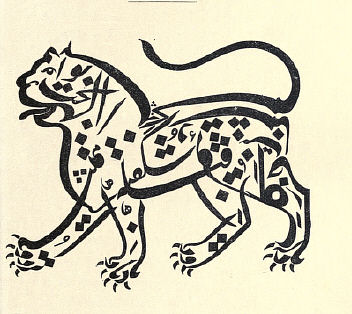
Abb.: सिंहः । Asiatischer Löwe = Panthera leo persica, indisch-persische
Kalligraphie von Munshi Sher Muhammad
[Bildquelle: Kipling, J. L.
<1837-1911>: Beast and man in India, 1904,
Widmung]
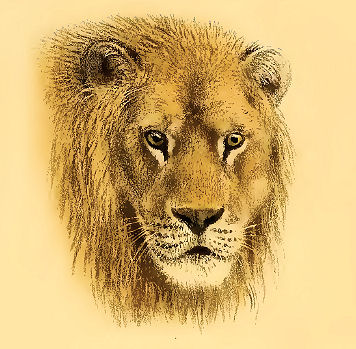
Abb.: हर्यक्षः
।
Panthera leo persica Meyer, 1826 -
Asiatischer Löwe
[Bildquelle: Lydekker, Richard <1849 - 1915>: The great and small game of
India, Burma, & Tibet. -- London, 1900. -- Pl. 8]
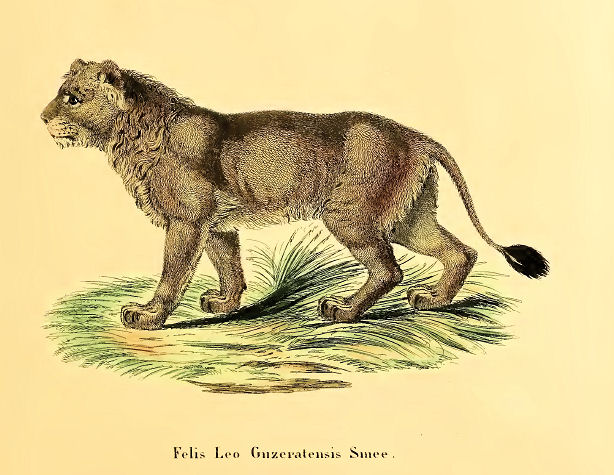
Abb.: हरिः । Felis leo guzeratensis - Gujarat-Löwe
[Bildquelle: Die Säugthiere in
Abbildungen nach der Natur, mit Beschreibungen von Johann Christian Daniel
von Schreber ... Fortgesetzt von d. August Goldfuss ..., 1797 - 1861. --
Tafel XCVII.C]
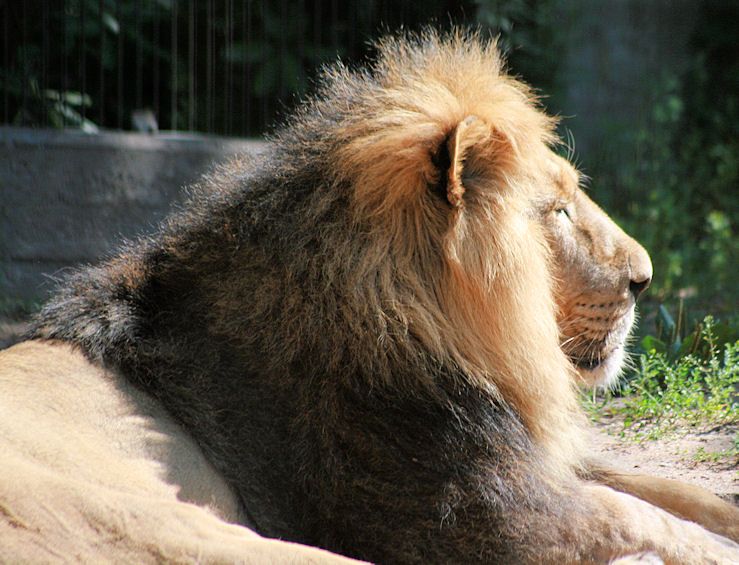
Abb.: केसरी । Panthera leo persica Meyer, 1826 -
Asiatischer Löwe, Männchen, Zoo
[Bildquelle: Madhusudhan Nanjappa / Wikipedia. -- GNU FDLicense]
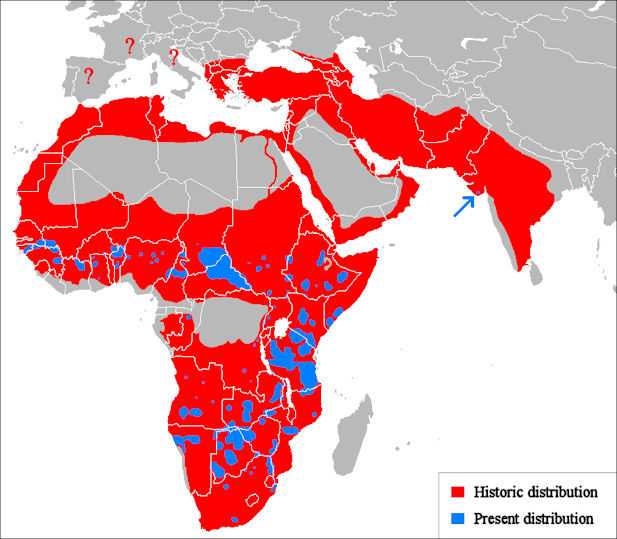
Abb.: Vergangene und gegenwärtige Lebensräume des Löwen
[Bildquelle:Tommyknocker / Wikipedia. -- Public domain]
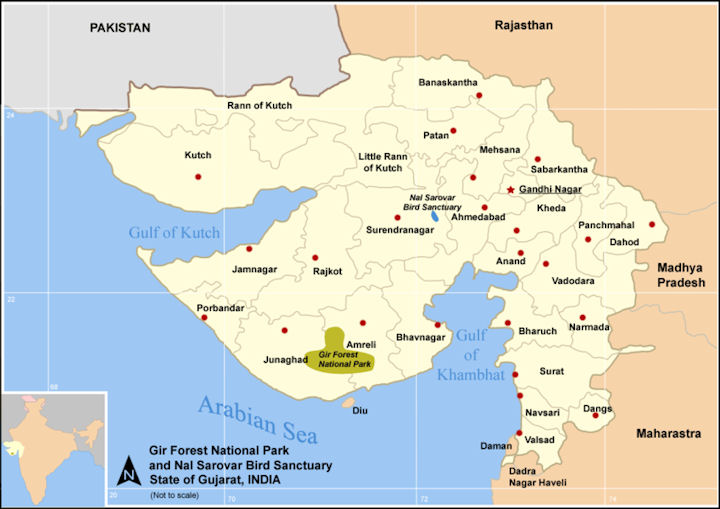
Abb.: Gir Forest National Park - ગીર રાષ્ટ્રીય ઉદ્યાન,
Gujarat, das
letzte Refugium des indischen Löwen, der einst in fast ganz Indien
beheimatet war
[Bildquelle: Miljoshi /
Wikimedia. -- GNU FDLicense]
Erläuterungen:
Siehe:
Carakasaṃhitā: Ausgewählte Texte aus der Carakasaṃhitā / übersetzt und erläutert von Alois Payer <1944 - >. -- Anhang B: Tierbeschreibungen. -- Panthera leo persica. -- URL: http://www.payer.de/ayurveda/tiere/panthera_leo_persica.htm
"The Lion is found in various parts of India, chiefly the North-west, from Cutch to Hurriana, Gwalior and Saugor, but is now only at all common in Guzrat and Cutch. I have heard of its having been killed south of the Nerbudda many years ago, and I have seen the skins of two that were obtained near Saugor a few years back, near which place, indeed, tolerably authentic intelligence was received of their presence in 1856 ; whilst quite recently two lions were killed most unexpectedly near Gwalior. In former years, lions were much more common in the eastern portion of their present habitat.
Little is recorded of the habits of the Lion as found in India. It is said to prey chiefly on bullocks and donkeys, and the fat is highly prized by the natives as a cure for rheumatism. Later and more authentic accounts of the habits of the Lion in Africa than those usually found in the older works on natural history, do not quite confirm those accounts of its noble character."
[Quelle: Jerdon, Thomas Claverhill <1811-1872>: The mammals of India : a natural history of all the animals known to inhabit continental India. -- London, 1874. -- S. 92.]
2.9.1.1. Löwe als vāhana
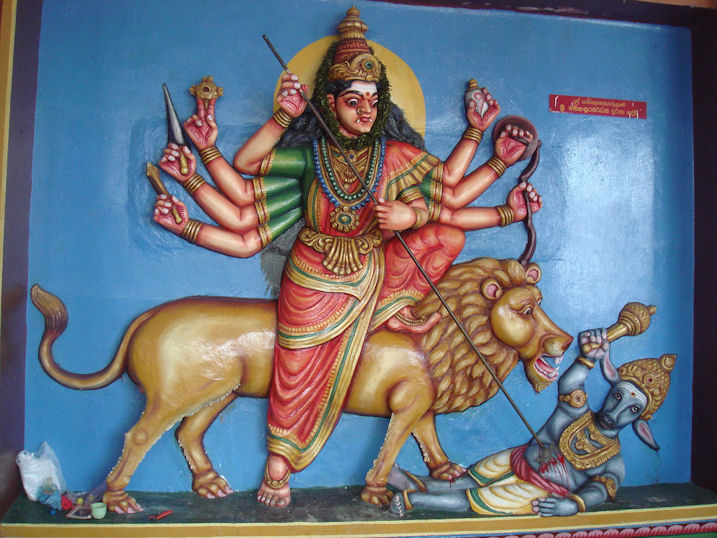
Abb.: Durgā Mahśāsuramardinī auf Löwe als Reittier,
Munneswaram - முன்னேசுவரம் , Sri Lanka
[Bildquelle:
Leon
Meerson. --
http://www.flickr.com/photos/lenchik/2968134636/. -- Zugriff am
2010-11-07. --
Creative
Commons Lizenz (Namensnennung, share alike)]
2.9.1.2. Narasiṃha
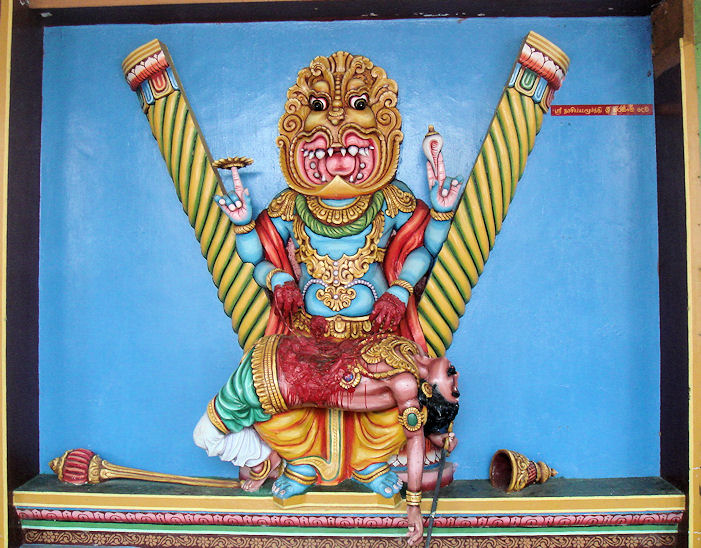
Abb.: Narasiṃha, Munneswaram - முன்னேசுவரம் , Sri Lanka
[Bildquelle:
Leon
Meerson. --
http://www.flickr.com/photos/37706524@N00/2968132498. -- Zugriff am
2010-12-09. --
Creative
Commons Lizenz (Namensnennung, share alike)]
"Nara-siṃha, or Nṛ-siṃha. 'The man-lion.' Vishnu assumed this form to deliver the world from the tyranny of Hiraṇyakaśipu, a demon who, by the favour of Brahmā, had become invulnerable, and was secure from gods, men, and animals. This demon's son, named Prahlāda, worshipped Vishnu, which so incensed his father that he tried to kill him, but his efforts were all in vain. Contending with his son as to the omnipotence and omnipresence of Vishnu, Hiraṇya-kaśipu demanded to know if Vishnu was present in a stone pillar of the hall, and struck it violently. To avenge Prahlāda, and to vindicate his own offended majesty, Vishnu came forth from the pillar as the Nara-siṃha, half-man and half-lion, and tore the arrogant Daitya king to pieces.
These four incarnations are supposed to have appeared in the Satya-yuga, or first age of the world."
[Quelle: Dowson, John <1820-1881>: A classical dictionary of Hindu mythology and religion, geography, history, and literature. -- London, Trübner, 1879. -- s.v. ]
2.9.1.3. Aśoka's Löwenkapitell
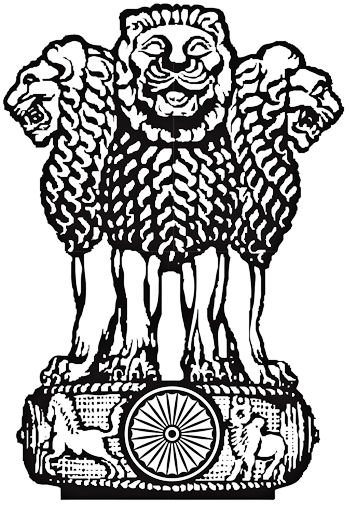
Abb.: Staatswappen Indiens: Aśoka's Löwenkapitell
[Bildquelle: Wikipedia. -- Public domain]
2.9.2. Panthera tigris tigris Linnaeus, 1758 - Königstiger - Bengal Tiger
| 1. c./d. śārdūla-dvīpinau vyāghre tarakṣus tu mṛgādanaḥ
शार्दूल-द्वीपिनौ व्याघ्रे
तरक्षुस् तु मृगादनः ॥१ ख॥
Bezeichnungen für व्याघ्र - vyāghra m.: Gähner = Panthera tigris tigris Linnaeus, 1758 -
Königstiger - Bengal Tiger: |
Colebrooke (1807): "A tiger." "Sing. द्वीपी (dvīpī). This, as a distinct species from the tiger, is the ounce; or else the panther."
Panthera tigris tigris Linnaeus, 1758 - Königstiger - Bengal Tiger
Körperlänge: 2,6 - 3 m.
Gewicht: 135 - 230 kg
Lebensraum: früher ganz Indien, jetzt isolierte Kleinräume
Noch in Freiheit lebende Individuen: 3750 - 4000
Lebt als Einzelgänger
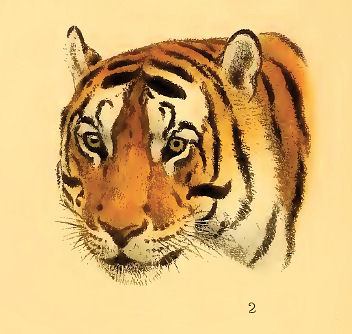
Abb.:
शार्दूलः ।
Panthera tigris tigris Linnaeus, 1758 -
Königstiger - Bengal Tiger
[Bildquelle: Lydekker, Richard <1849 - 1915>: The great
and small game of India, Burma, & Tibet. -- London, 1900. -- Pl. 8]
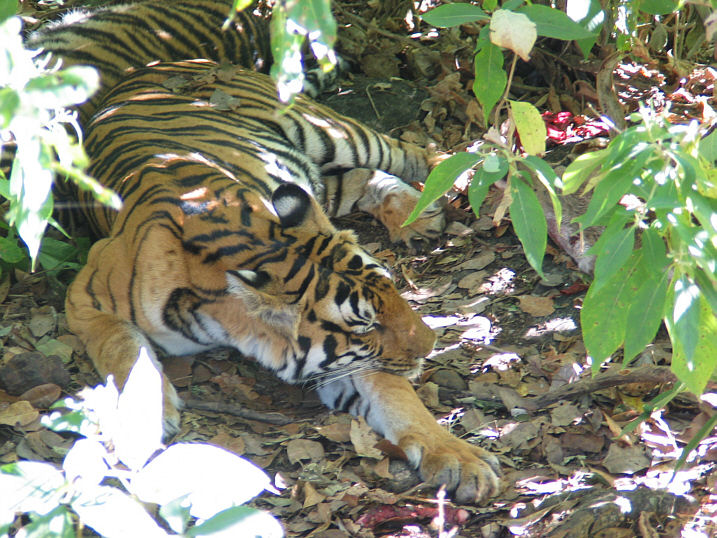
Abb.: द्वीपी । Panthera tigris tigris Linnaeus, 1758 -
Königstiger - Bengal Tiger,
Kanha National Park - कान्हा राष्ट्रीय उद्यान, Madhya Pradesh, 2006
[Bildquelle:
Begemot. --
http://www.flickr.com/photos/begemot/92474080/. -- Zugriff am
2007-07-15. --
![]()
![]()
![]() Creative
Commons Lizenz (Namensnennung, keine kommerzielle Nutzung, keine
Bearbeitung)]
Creative
Commons Lizenz (Namensnennung, keine kommerzielle Nutzung, keine
Bearbeitung)]
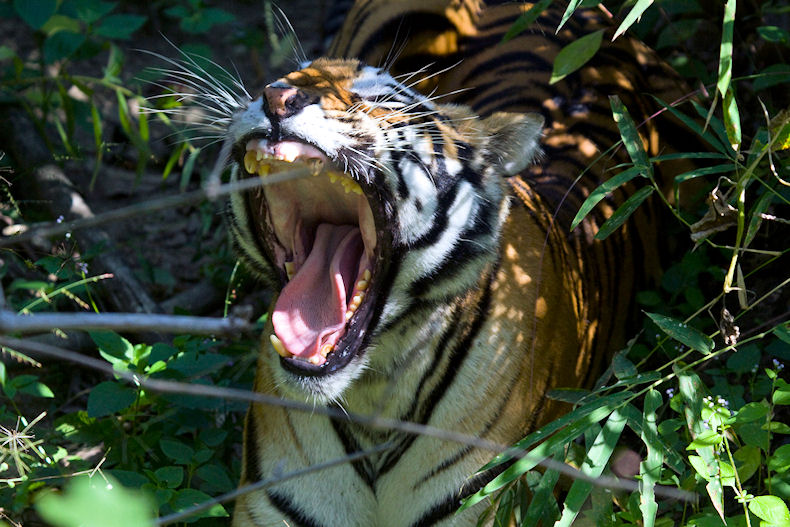
Abb.: व्याघ्रः । Gähnender Tiger, Kanha National Park - कान्हा राष्ट्रीय उद्यान,
Madhya Pradesh
[Bildquelle: Brian Scott. --
http://www.flickr.com/photos/brianscott/4106079530/. -- Zugriff am
2010-12-09. --
Creative Commons Lizenz (Namensnennung, keine kommerzielle Nutzung, keine
Bearbeitung)]
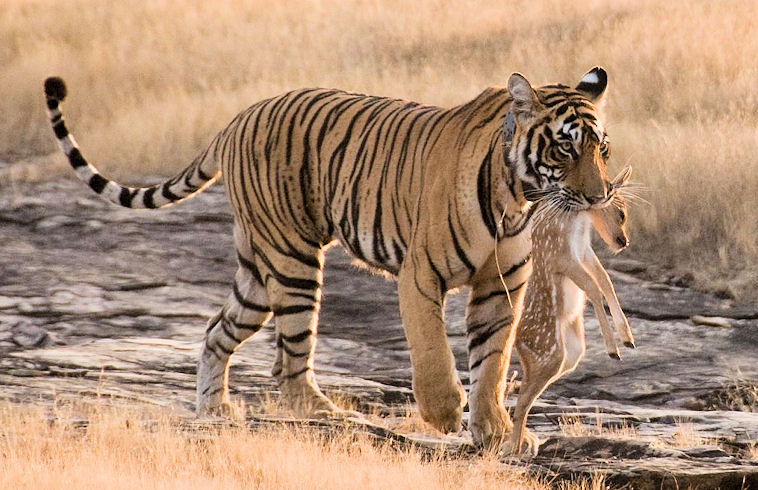
Abb.: Tiger mit Beute, Ranthambore National Park - रणथम्भौर राष्ट्रीय
अभ्यारण्य, Rajasthan
[Bildquelle: Andrew Miller. --
http://www.flickr.com/photos/govmilliken/3020146620/. -- Zugriff am
2010-12-09. --
Creative Commons Lizenz (Namensnennung, keine kommerzielle Nutzung)]
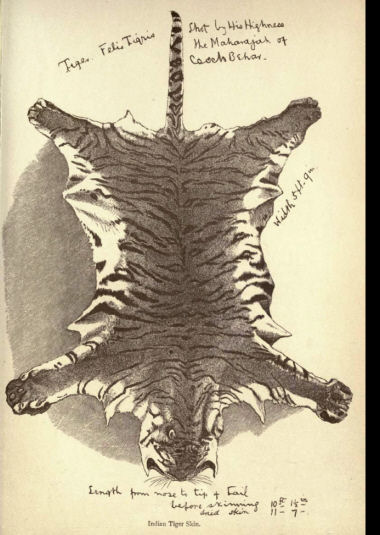
Abb.:
Panthera tigris tigris Linnaeus, 1758 -
Königstiger - Bengal Tiger, ermordet von S. kgl. Hoheit, dem Maharaja von
Cooch Behar
[Bildquelle: Ward, 1903]
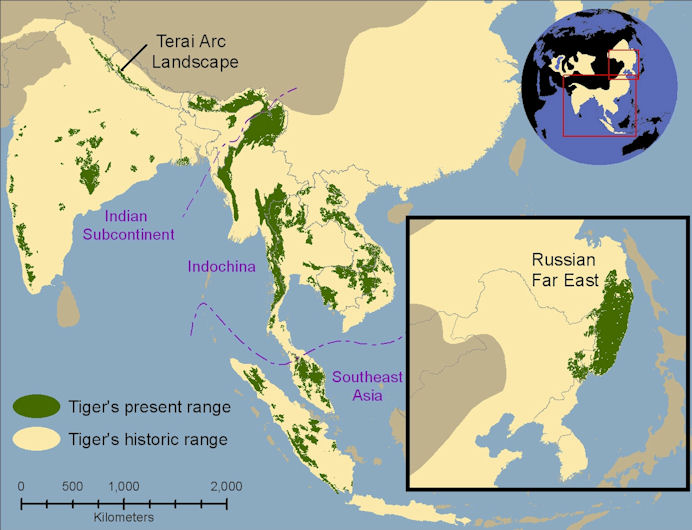
Abb.: Vergangene und gegenwärtige Lebensräume des Tigers
[Bildquelle: Eleassar
/ Wikipedia. --
Creative Commons Lizenz (Namensnennung)]
Erläuterungen:
Siehe:
Carakasaṃhitā: Ausgewählte Texte aus der Carakasaṃhitā / übersetzt und erläutert von Alois Payer <1944 - >. -- Anhang B: Tierbeschreibungen. -- Panthera tigris tigris. -- URL: http://www.payer.de/ayurveda/tiere/panthera_tigris_tigris.htm
"The Tiger is found throughout all India, from Cape Comorin to the Himalayas, ascending the hills occasionally to an elevation of 6,000 or 7,000 feet. It is found in all the forests and jungles throughout the peninsula, occasionally visiting the more open and cultivated parts of the country, and harbouring in thickets, long grass, and especially in brushwood on river-banks, and on churs covered with tamarisk. In the hot weather, indeed, these are its favourite resorts in many parts of Central India, and from there it sallies forth towards the villages in search of food. In lower Bengal the heavy grass jungles and swamps are his usual lair. Tigers are perhaps more abundant in lower Bengal than in most other parts of the country, and are said to be both larger and more savage than those from other parts of India. Those of Central India, however, are perhaps as large, and quite, if not more ferocious than their Bengal brethren.
The average size of a full-grown male tiger is from 9 to 9 1/2 feet in length, but I fancy there is very little doubt that, occasionally, tigers are killed 10 feet in length, and perhaps a few inches over that; but the stories of tigers 11 feet and 12 feet in length, so often heard and repeated, certainly require confirmation, and I have not myself seen an authentic account of a tiger that measured more than 10 feet and 2 or 3 inches. Major Sherwill, who was for some years in Dinagepore district, told me that the largest he had seen killed was 9 feet 8 inches. The skin is very often measured either when fresh taken from the carcass, or after it has been stretched out to dry ; and Mr. W. Elliot records an instance of a lion measured by himself at 9 feet 4 inches. This was noted by one of the party as 11 feet and by another as 12 feet, the first measurement being taken from the skin when taken off ; the other from the skin stretched out by pegs for drying.
Mr. Walter Elliot has the following remarks on the distribution and habits of this animal in Southern India. "The Tiger is common over the whole district, breeding in the forest and mountain tracts, and coming into the open country when the grain is on the ground. In some places they do much mischief, and have been known to carry off the inhabitants out of the villages whilst sleeping in their verandahs during the night. The female has from two to four young, and does not breed at any particular season. Their chief prey is cattle, but they also catch the wild hog, the sambar, and more rarely the spotted deer. It is naturally a cowardly animal, and always retreats from opposition, until wounded or provoked. Several instances came to notice of its being compelled to relinquish its prey by the cattle in a body driving it off. In one case an official report was made of a herd of buffaloes rushing on a tiger that had seized the herd-boy, and forcing it to drop him. Its retiring from the wild hog has been already adverted to. Though the wild hog often becomes its prey, it sometimes falls a victim to the successful resistance of the wild boar. I once found a full-grown tiger newly killed, evidently by the rip of a boar's tusk ; and two similar instances were related to me by a gentleman who had witnessed them one of a tiger, the other of a panther. It is generally believed a tiger always kills his own food, and will not eat carrion. I met with one instance of a tigress and two full-grown cubs devouring a bullock that had died of disease. I saw the carcass in the evening: next day, on the report of tigers having been heard in the night, I followed their track, and found she had dragged the dead animal into the centre of a cornfield, and picked the bones quite clean, after which she found a buffalo, killed it, and eat only a small portion of it. Another instance was related in a letter from a celebrated sportsman in Khandeish, who having killed a tigress, on his return to his tents sent a pad elephant to bring it home. The messenger returned reporting that on his arrival he found her alive. They went out next morning to the spot, and discovered that she had been dragged into a ravine by another tiger and half the carcass devoured. They found him close by, and killed him also. The Bheels in Khandeish say that in the monsoon, when food is scarce, the Tiger feeds on frogs, and an instance occurred some years ago in that province of one being killed in a state of extreme emaciation from a porcupine's quill that had passed through his gullet, and prevented his swallowing, and which had probably been planted there in his attempt to make one of these animals his prey. Many superstitious ideas prevail among the natives regarding the Tiger. They imagine that an additional lobe is added to his liver every year ; that his claws arranged together so as to form a circle, and hung round a child's neck, preserve it from the effect of the evil eye ; that the whiskers constitute a deadly poison, which for this reason are carefully burnt off the instant the animal is killed. Several of the lower castes eat his flesh."
The late Major Sherwill, of the Revenue Survey, gave me some interesting information on the habits of the Tiger, as observed by him in the Dinagepore district the substance of which is as follows : Tigers are very partial to certain localities, and avoid others to all appearance quite as favourable cover. Year after year they will be found in one locality and killed, and never be seen in another close at hand, apparently just as suitable. They are very fond of ruins, and may often be seen lying on the top of old walls, temples, &c. ; sometimes three or four together. Generally speaking, the Bengal Tiger is a harmless, timid animal, but when wounded he becomes ferocious and dangerous. He seldom molests man without provocation, and man-eaters are very scarce in Bengal, except in the vicinity of the Sunderbuns. A tigress has from two to four cubs at a time, which remain with her until they are able to kill for themselves. Young tigers are by far the most mischievous, occasionally killing as many as four or five cows at once, whilst an old one seldom kills more than what it requires for its food. An old tiger will kill a cow about once a week, and for this purpose will quit its place of retreat in dense jungle, proceed to the vicinity of a village and kill a bullock or cow. It will remain near the "kill" for two or three days, and sometimes longer, gnawing the bones before retreating to deep cover. A tigress deposits her young in good cover. Two taken by Major Sherwill were laid under a thorn bush in dense jungle. Nulla grass appears to be a favourite place for breeding in. The mother appears much distressed onlosing her young, and for three or four nights afterwards remains at the spot roaring all night in a very excited manner.
The few remaining observations must be considered as supplementary to the previous observations of Messrs. Elliot and Sherwill. When once a tiger takes to killing man, it almost always perseveres in its endeavours to procure the same food ; and, in general, it has been found that very old tigers, whose teeth are blunted or gone, and the vigour of whose strength is faded, are those that relish human food, finding it a much more easy prey than cattle. In some parts of Central India, however, it appears to be more the rule than the exception ; and in the Mundlah district, east from Jubbulpore, in 1856, and previous years, on an average between two and three hundred villagers were killed annually. So dire was the destruction that Major Erskine, the Commissioner, applied to the Madras Government to furnish an officer for the special work of thinning these cannibals. In the Bustar country, south-east of Nagpore, when I traversed part of that then unexplored district, I found that in several parts the villages were deserted, entirely, as I was informed, from the ravages of tigers, although, in some instances, the villages had been surrounded by a high stockade. In the Bengal Sunderbuns too many wood-cutters are (or used to be) annually carried off.
Tiger hunting is generally done from elephants in Northern India and a well-trained shikaree elephant will stand the charge of a tiger well, occasionally even rushing to meet it, which is by no means agreeable to the sportsman in the howdah. In Southern India, where there are but few elephants kept, the Tiger is often successfully slain on foot ; but it is at all times a dangerous sport, and many serious and fatal accidents are well known to have occurred. Occasionally a tiger is shot by night from a platform on a tree, either close to where the tiger has killed, but not eaten all his prey, or, with a fresh bullock picketed near. In the Wynaad one class of Hindoos assemble in large numbers, and forming a large circle, drive the Tiger into a net, where it is speared. Various modes of capture are practised all over India, and strychnine has been had resort to occasionally to destroy this animal ; but in spite of the numbers killed annually by sportsmen, and by native shikarees for the sake of the Government reward, in many districts its numbers appear to be only slightly diminished.
The native idea about the Tiger getting an additional lobe to its liver every year has been fully taken up by English sportsmen, and in the pages of the Bengal Sporting Magazine, &c., the number of lobes in the livers of tigers whose death is there chronicled, are duly recorded. The clavicle lies loosely imbedded among the muscles near the shoulder-joint, and is considered of great virtue by natives. The whiskers are, in some parts of Southern India, considered to endow the fortunate possessor with unlimited power over the opposite sex. The claws are mounted in silver and made into bracelets.
The Tiger is peculiar to Asia, extending as far west as Georgia, through Persia to Bokhara, and is also found in Amurland, in the Altai region, and China ; thence extending south through Burmah to the Malayan peninsula, and some of the neighbouring larger islands. It is not found in Ceylon."
[Quelle: Jerdon, Thomas Claverhill <1811-1872>: The mammals of India : a natural history of all the animals known to inhabit continental India. -- London, 1874. -- S. 93ff.]
2.9.2.1. Tiger als vāhana
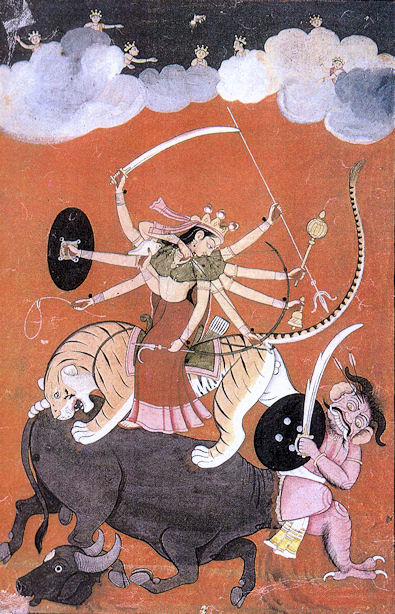
Abb.: Devī als Mahiṣāsuramardinī auf Tiger reitend, 18. Jhdt.
[Bildquelle: Wikipedia. -- Public domain]
2.9.2.2. Tiger als Wandschmuck (Gefahrenabwehr?)
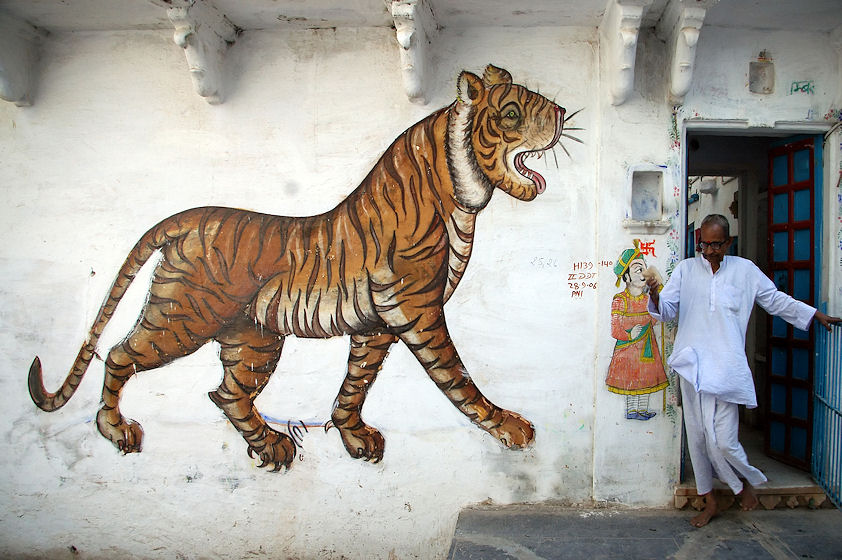
Abb.: Tiger, Wandmalerei, Udaipur - उदयपुर, Rajasthan
[Bildquelle: Dave Morris. --
http://www.flickr.com/photos/davemorris/362611897/. -- Zugriff am
2010-12-09. --
Creative Commons Lizenz (Namensnennung, keine kommerzielle Nutzung, share
alike)]
2.9.3. Hyaena hyaena Linnaeus, 1758 - Streifenhyäne - Striped Hyena
| 1. c./d. śārdūla-dvīpinau vyāghre tarakṣus tu mṛgādanaḥ शार्दूल-द्वीपिनौ व्याघ्रे तरक्षुस् तु मृगादनः ॥१ ख॥ [Bezeichnunge für Hyaena hyaena Linnaeus, 1758 - Streifenhyäne - Striped Hyena:]
|
Colebrooke (1807): "A hyena. Some suppose a leopard to be meant."
Hyaena hyaena Linnaeus, 1758 - Streifenhyäne - Striped Hyena
Körperlänge: 150 - 160 cm
Gewicht: 26 - 41 kg
Lebensraum: ganz Indien außer Jammu und Kashmir und Nordostindien, Strauchwälder
und in der Nähe menschlicher Behausungen, bis 1500 m. ü. M.
Noch in Freiheit lebende Individuen: unbekannt
Lebt als Einzelgänger bzw. in Familiengruppem
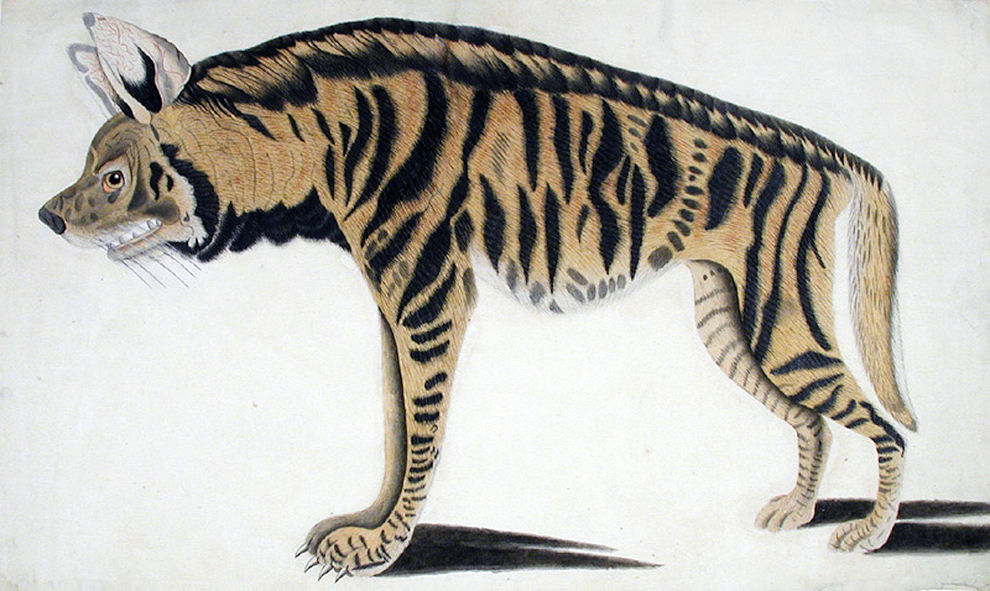
Abb.: तरक्षुः
।
Hyaena hyaena Linnaeus, 1758 -
Streifenhyäne - Striped Hyena, nach 1795
[Bildquelle: Asian Curator at The San Diego Museum of
Art. --
http://www.flickr.com/photos/asianartsandiego/4837919317/. -- Zugriff am
2011-03-06. --
Creative Commons Lizenz (Namensnennung, keine kommerzielle Nutzung,
keine Bearbeitung)]
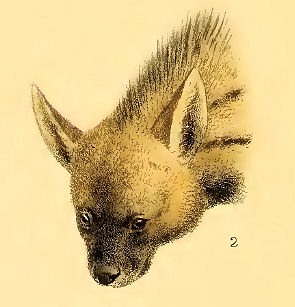
Abb.: तरक्षुः
।
Hyaena hyaena Linnaeus, 1758 -
Streifenhyäne - Striped Hyena
[Bildquelle: Lydekker, Richard <1849 - 1915>: The great and small
game of India, Burma, & Tibet. -- London, 1900. -- Pl. 9]
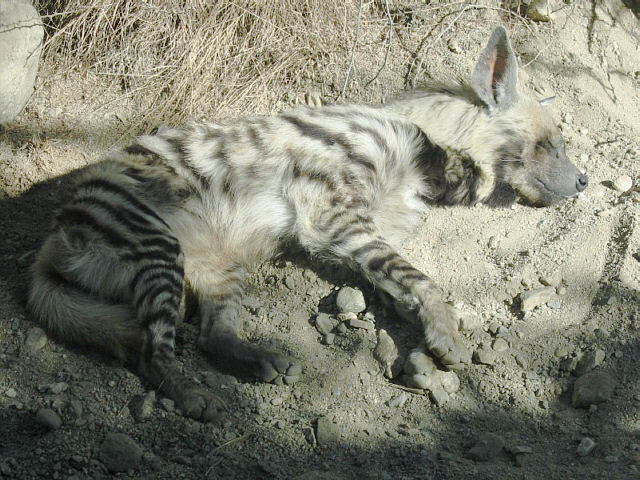
Abb.: तरक्षुः
।
Hyaena hyaena Linnaeus, 1758 -
Streifenhyäne - Striped Hyena, Zoo
[Bildquelle:
rainfairy. --
http://www.flickr.com/photos/rainfairy/93237270/. -- Zugriff am
2007-07-15. --
![]()
![]()
![]() Creative
Commons Lizenz (Namensnennung, keine kommerzielle Nutzung, keine
Bearbeitung)]
Creative
Commons Lizenz (Namensnennung, keine kommerzielle Nutzung, keine
Bearbeitung)]
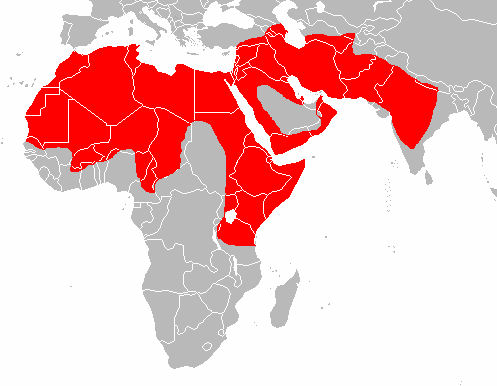
Abb.: Ungefährer Lebensraum der Streifenhyäne
[Bildquelle: Bradypus / Wikipedia. -- GNU FDLicense]
Erläuterungen:
Siehe:
Carakasaṃhitā: Ausgewählte Texte aus der Carakasaṃhitā / übersetzt und erläutert von Alois Payer <1944 - >. -- Anhang B: Tierbeschreibungen. -- Hyaena hyaena. -- URL: http://www.payer.de/ayurveda/tiere/hyaena_hyaena.htm
"The Hyaena is common over the greater part of India, most rare in the forest districts, and abundant in open country, especially where low hills and ravines offer convenient spots for the holes and caverns it frequents. It is not enumerated by Kelaart from Ceylon. It is quite nocturnal, sallying forth after dark and hunting for carcasses, the bones of which it gnaws, occasionally catching some prowling dog, or stray sheep as a "bonne bouche." Adams says that it is "very destructive to poultry." This I have not heard noticed elsewhere. Now and then one will be found in the early morning making its way back to its den, but in general it is safe in its lair long before sunrise. I have more than once turned one out of a sugar-cane field when looking for jackals, and it very commonly lurks among ruins ; but in general its den is in a hole dug by itself on the side of a hill or ravine, or a cave in a rock. The call of the Hyaena is a very disagreeable unearthly cry, and dogs are often tempted out by it when near, and fall a victim to the stealthy marauder. On one occasion a small dog belonging to an officer of the Madras 33rd N. I., was taken off by a hyaena very early in the morning. The den of this beast was known to be not far off in some sandstone cliffs (at Dumoh, near Saugor), and some sepoys of the detachment went after it, entered the cave, killed the hyaena, and recovered the dog alive, and with but little damage done to it !
A hyaena, though it does not appear to move very fast, gets over rough ground in a wonderful manner, and it takes a good long run to overtake it on horseback unless in most favourable ground. A stray hyaena is now and then met with by a party of sportsmen, followed and speared ; but sometimes not till after a run of three or four miles if the ground is broken by ravines. It is a cowardly animal, and shows but little fight when brought to bay. The young are very tameable, and show great signs of attachment to their owner, in spite of all that has been written about the untameable ferocity of the Hyaena."
[Quelle: Jerdon, Thomas Claverhill <1811-1872>: The mammals of India : a natural history of all the animals known to inhabit continental India. -- London, 1874. -- S. 119.]
Panthera pardus Linnaeus, 1758 - Common Leopard - Leopard
Körperlänge: 1.85 - 2.15 m
Gewicht: 39 - 68 kg
Lebensraum: ganz Indien, bis 3000 m ü. M.
Noch in Freiheit lebende Individuen: ca. 20.000
Lebt als Einzelgänger
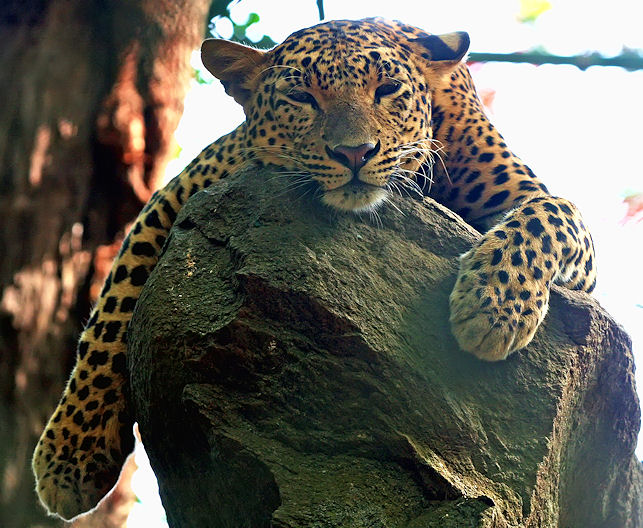
Abb.:
मृगादनः
।
Panthera pardus Linnaeus, 1758 - Common Leopard - Leopard,
Bannerghatta National Park - ಬನ್ನೇರುಘಟ್ಟ ನ್ಯಾಷನಲ್ ಪಾರ್ಕ್, Karnataka
[Bildquelle: Muhammad Mahdi Karim / Wikimedia. -- GNU FDLicense]
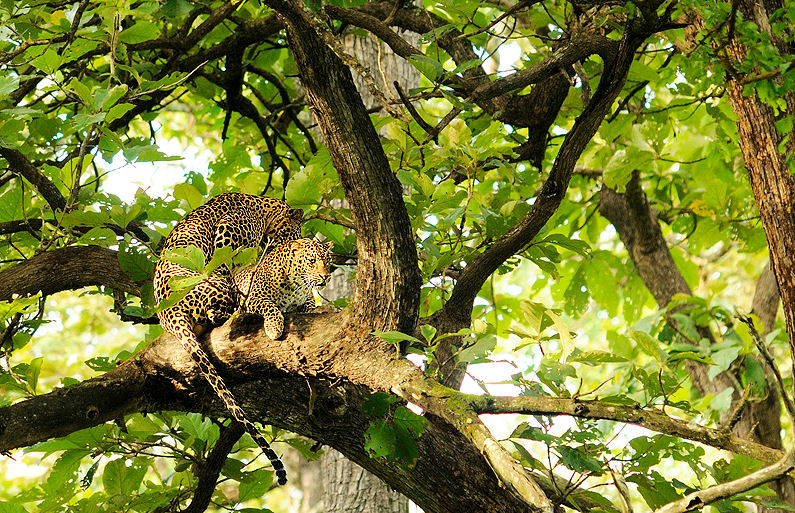
Abb.: Panthera pardus Linnaeus, 1758 - Common Leopard - Leopard, Kabini (ಕಬಿನಿ)
Wildlife Sanctuary, Karnataka
[Bildquelle: T. A. Joseph. --
http://www.flickr.com/photos/josephta/4798508507/. -- Zugriff am 2011-01-01.
-- Creative
Commons Lizenz (Namensnennung, keine kommerzielle Nutzung)]
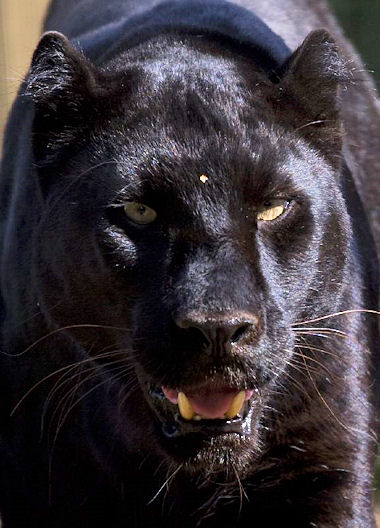
Abb.: Panthera pardus Linnaeus, 1758 - Common Leopard - Leopard,
Schwärzling ("Panther"), Santago Rare Leopards Project, Welwyn, Hertfordshire,
UK
[Bildquelle:
Brian Scott. --
http://www.flickr.com/photos/brianscott/1234882976/. -- Zugriff am
2011-01-01. --
Creative
Commons Lizenz (Namensnennung, keine kommerzielle Nutzung, keine
Bearbeitung)]
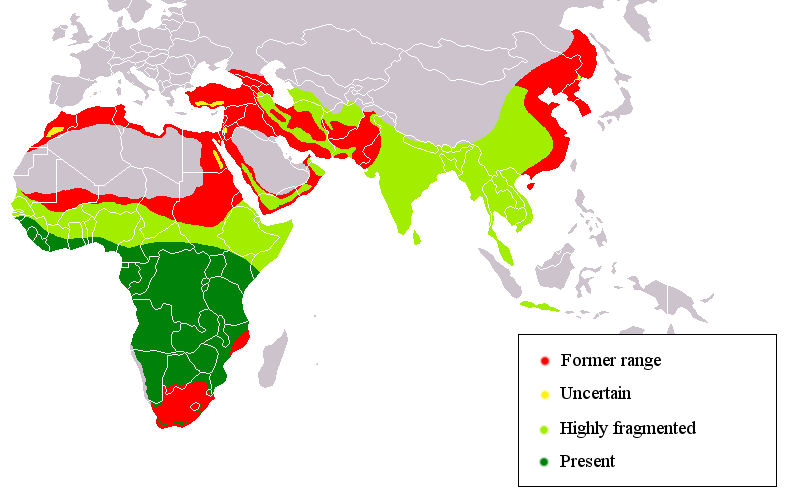
Abb.: Lebensräume von Panthera pardus Linnaeus, 1758 - Common Leopard -
Leopard
[Bildquelle: Tommyknocker / Wikipedia. -- Public domain]
"The leopard is one of the three larger cats which are common to India and Africa ; the other two being the lion and the hunting-leopard. The distribution of the leopard is, however, more extensive than that of the lion, embracing nearly the whole of Asia, from Persia to Japan, but not extending as far north as Siberia ; while the animal is unknown on the high plateau of Tibet, where almost all the Mammals belong to peculiar species not found elsewhere.
Leopards occur over almost the whole of India, although absent from parts of Sind and the Punjab ; and they are abundant in Ceylon, Burma, and the islands of the Malayan region. Westward they extend into Persia, Palestine, Arabia, and Syria, and thence into Africa, where they range from Somaliland and Algeria to the Cape Colony. [...] Its distribution is and was considerably more extensive than that of the lion, which, as we have seen, never extended eastwards of the Bay of Bengal ; and it is larger than that of any other member of the Cat family except the lynx.
Next to the tiger in India, and to the lion in Africa, the leopard is the most formidable Carnivore (exclusive in India of bears) to be found in either country. In its habits it differs essentially from both the lion and the tiger in that it is thoroughly at home in trees, running up a straight-stemmed and smooth-barked trunk with the speed and agility of a monkey. Moreover, the leopard is a much more active animal than the tiger, frequently taking tremendous leaps and springs, Mr. Sanderson is of opinion that the Indian leopard, although its powers of offence are far inferior to those of the tiger, is in some respects a more dangerous animal, as it is roused with less provocation, and is more courageous in attacking those who disturb its repose. The favourite resorts of the Indian leopard are rocky hills covered with scrub, among which it seeks secure hiding in caves and under overhanging masses of rock. From strongholds such as these, writes Mr. Sanderson, the leopards in Southern and Central India "watch the surrounding country towards sunset, and descend with astonishing celerity and stealth, under cover of the rocks, to cut off any straggling animal among the herds or flocks on their return to the village at nightfall. From their habit of lurking in the vicinity of the habitations of man, to prey upon cattle, ponies, donkeys, sheep, goats, and dogs, leopards are frequently brought into collision with Indian villagers ; and a leopard being mobbed in a garden, or field of sugar-cane or standing corn, from which he will charge several times, and bite and claw half a dozen before he is despatched or makes his escape, is no uncommon occurrence in India. At night leopards frequently find their way into goat-folds or calf-pens, climbing over walls or the roofs of native huts in their burglarious inroads, and carrying off their prey with great boldness and agility. They appear to have a peculiar penchant for dogs ; and I have known many villages in parts of Mysore where leopards were numerous, in which not a dog was to be found, or perchance but one or two, which would be pointed out by their owners as very lucky ones, they having escaped sometimes from the very clutches of their unceasing foe, whilst their companions had successively fallen victims to his stealthy attacks."
This partiality of the leopard for dogs seems to be characteristic of the animal from one end of India to the other, and there are many instances on record where leopards in the hill-stations have swooped down in broad daylight and carried off pet dogs from before the very eyes of their European masters or mistresses. It is but rarely that leopards take to man-eating, but instances do occur, one of which came under the notice of the present writer some years ago, when a leopard carried off a considerable number of persons from a village in Kashmir. In Africa the general habits of the leopard appear to be very much the same as in India, Sir Samuel Baker relating how, on one occasion, a dog was carried off from the very middle of his camp by one of these marauders.
In addition to dogs, which can, of course, be obtained only in the neighbourhood of villages, leopards prey largely upon the langurs and other monkeys which haunt the rocky hills. Indeed, few animals come amiss in the way of food; about the largest which he is capable of killing being the sambar deer, or an Indian bullock.
In killing its prey, the leopard, writes Sir Samuel Baker, seizes by the throat, and clings with tenacious claws to the animal's neck, until it succeeds either in breaking the spine or in strangling the victim, should the bone resist its strength. When the animal is dead, the leopard never attacks the hind-quarters first, according to the custom of the tiger, but it tears the belly open and drags out all the viscera, making its first meal upon the heart, lungs, liver, and inside generally. It then retreats to some neighbouring hiding-place, and, if undisturbed, it will return to its prey a little after sundown on the following day. Mr. H. Hunter remarks that in Africa the leopard nearly always puts the remains of his "kill" up a tree, probably for the purpose of protecting it from the attacks of hyaenas. On one occasion the skeleton of a lesser kudu antelope was found in the fork of a branch, which it was believed had been placed there by a leopard, and Mr. Hunter on several occasions saw one of these animals descending from a tree.
It has yet to be mentioned that the leopard does not display that marked partiality for the neighbourhood of water so characteristic of the tiger, many of its haunts in the hills being in districts which are absolutely dry. On occasion, however, it will take to the water as readily, and swim as well as a tiger. Although usually found singly or in pairs, leopards, in Africa at least, may sometimes be found in parties comprising several full-grown individuals; probably, however, these are all members of a single family. The leopard is a still more silent animal than the tiger, seldom giving vent to any sound, except when disturbed or charging an enemy, when it utters a short roar. According to Captain Baldwin, who is supported by Mr. Blanford, its real cry, which is but seldom heard, is quite different from the roar of a tiger, and takes the form of a harsh noise, something between a grunt and a cough, which is repeated three or four times. In India the female leopard gives birth to its young in the spring, during the months of February and March, two, three, or four cubs composing a litter. Young leopards are said to be more difficult to tame than either lions or tigers, and the adult when in captivity always displays an uncertain and morose disposition.
With regard to leopard-hunting, Sir Samuel Baker observes that "it is far more difficult to circumvent a leopard than a tiger. The latter seldom or never looks upwards to the trees, therefore it does not perceive the hidden danger when the hunter is watching from his elevated post ; but the leopard approaches its 'kill' in the most wary and cautious manner, crouching occasionally, and examining every yard of the ground before it, at the same time scanning the overhanging boughs, which it so frequently seeks as a place of refuge. Upon many occasions, when the disappointed watcher imagines that the leopard has forsaken its 'kill,' and that his patience will not be unrewarded, the animal may be closely scanning him from the dense bush, under cover of which it was noiselessly approaching. In such a case the leopard would retreat as silently as it had advanced, and the watcher would return home from a fruitless vigil, under the impression that the animal had never been within a mile of his position. . . . There is very little sport afforded by this stealthy animal, and it is almost useless to organise a special hunt, as it is impossible to form any correct opinion respecting its locality after it has killed an animal. It may either be asleep in some distant ravine, or among the giant branches of some old tree, or beneath the rocks of some adjacent hill, or retired within a cave, but it has no special character or custom that would guide the hunter in arranging a beat according to the usual rules in the case of tigers."
Leopards are, however, much less suspicious of traps than are tigers, and still more so than lions, and, accordingly, a large number are thus caught. In India they are frequently taken alive in the cage-trap, to which we have already referred under the head of the tiger ; such traps being generally baited with a dog, goat, or calf, which attracts the leopard by its cries. In Africa a trap like a large fox-trap is, however, generally employed ; and so bold in some parts are leopards that Mr. Hunter states that once during dinner-time he caught one in a trap which was set within fifteen yards' distance of the table at which he was sitting."
[Quelle: The royal natural history / ed. by Richard Lydekker [1849 - 1915]. -- London. -- Vol 1. -- 1893/94. -- S. 387ff.]
2.9.4. Sus scrofa cristatus Wagner, 1839 - Wildschwein - Wild Boar
| 2. varāhaḥ sūkaro ghṛṣṭiḥ kolaḥ potrī kiraḥ kiṭiḥ daṃṣṭrī ghoṇī stabdharomā kroḍo bhūdāra ity api
वराहः सूकरो घृष्टिः कोलः पोत्री किरःa किटिः ।
a var. lect. किरिः - kiriḥ
[Bezeichnungen für
Sus scrofa
cristatus Wagner, 1839 - Wildschwein - Wild
Boar:] |
Colebrooke (1807): "A hog."
Sus scrofa cristatus Wagner 1839, - Wildschwein - Wild Boar
Körperlänge: 90 - 180 cm
Gewicht: 90 - 100 kg
Lebensraum: ganz Indien, außer Jammu und Kashmir, Himalaya-Hochgebirge und
Wüsten
Noch in Freiheit lebende Individuen: unbekannt
Lebt in Gruppen von 5 - 30 Tieren
1 घृष्टि - ghṛṣṭi m.: Reiber, Sich-Wetzer
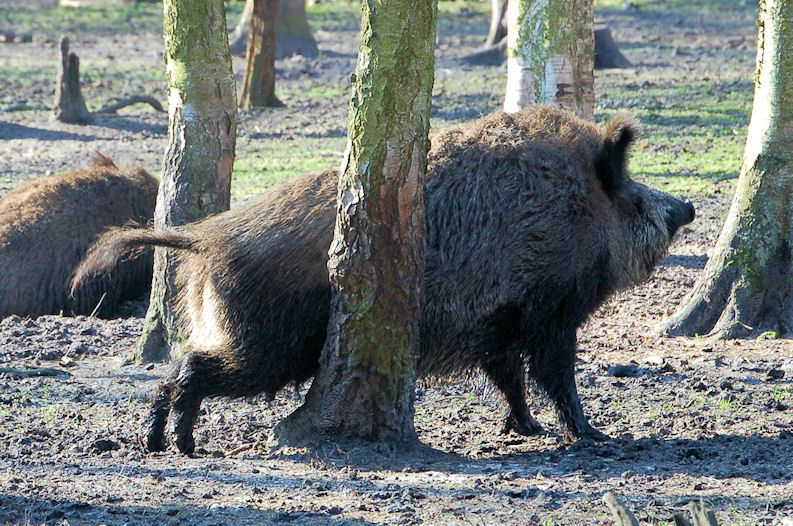
Abb.: घृष्टिः । Deutschland
[Bildquelle: Huhu Uet / Wikimedia. -- GNU FDLicense]
2 भूदार - bhūdāra m.: der den Boden aufreißt
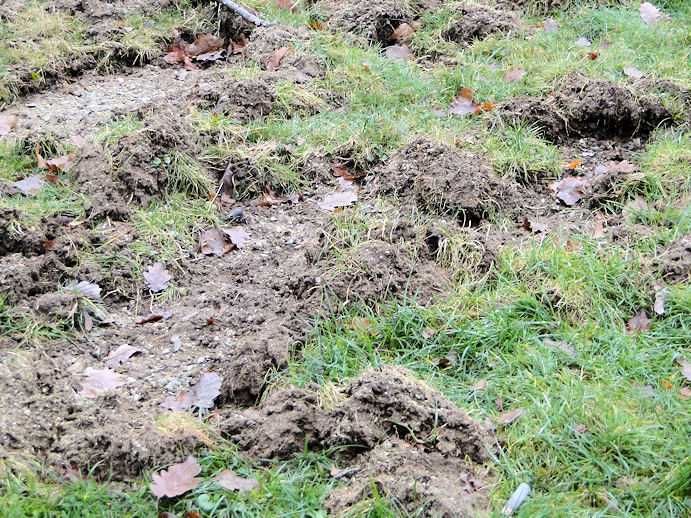
Abb.: भूदार: । Von Wildschweinen
aufgerissener Boden.
[Bildquelle: Dontworry / Wikimedia. --
Creative Commons Lizenz (Namensnennung, share alike)]
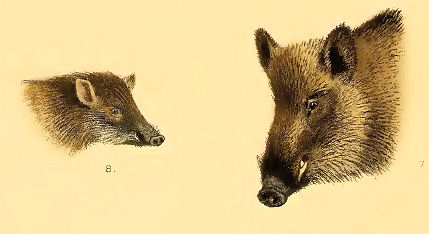
Abb.: 7. Sus scrofa
cristatus Wagner, 1839 - Wildschwein - Wild
Boar ; 8. Porcula salvania Hodgson, 1847 - Zwergwildschwein - Pygmy hog
[Bildquelle: Lydekker, Richard <1849 - 1915>: The great and small
game of India, Burma, & Tibet. -- London, 1900. -- Pl. 7]
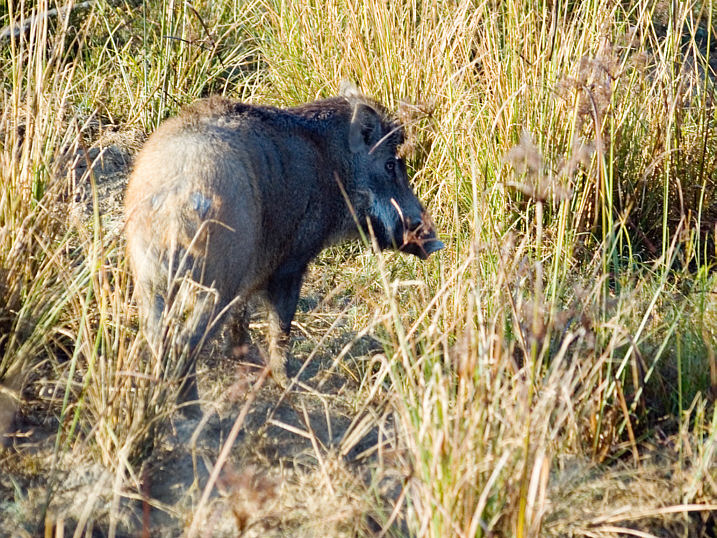
Abb.: दंष्ट्री
।
Sus scrofa cristatus Wagner, 1839 - Wildschwein - Wild Boar, Jim Corbett National Park, Uttarakhand (उत्तराखंड)
[Bildquelle:
Peter Davis. --
http://www.flickr.com/photos/pediddle/327822607/. -- Zugriff am
2007-07-17. --
![]()
![]()
![]() Creative
Commons Lizenz (Namensnennung, keine kommerzielle Nutzung, keine
Bearbeitung)]
Creative
Commons Lizenz (Namensnennung, keine kommerzielle Nutzung, keine
Bearbeitung)]
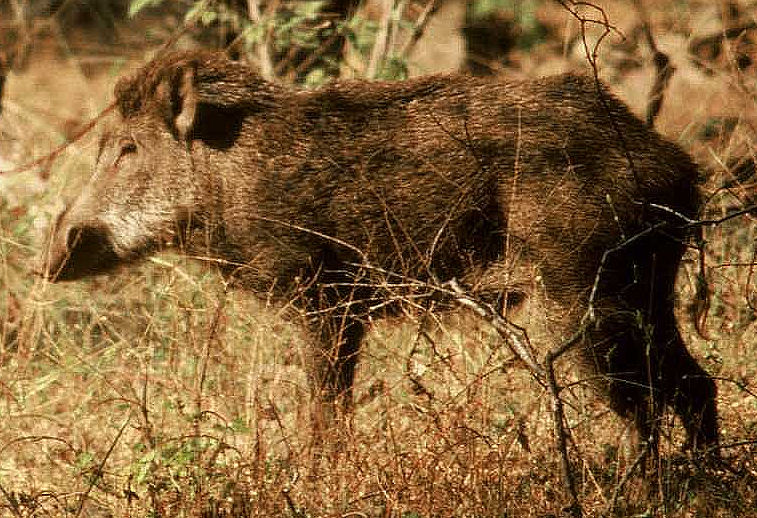
Abb.: स्तब्धरोमा ।
Sus scrofa
cristatus Wagner, 1839 - Wildschwein - Wild
Boar, Ranthambore National Park -
रंथांबोर राष्ट्रीय उद्यान, Rajasthan
[Bildquelle: Altaipanther / Wikimedia. -- Public domain]
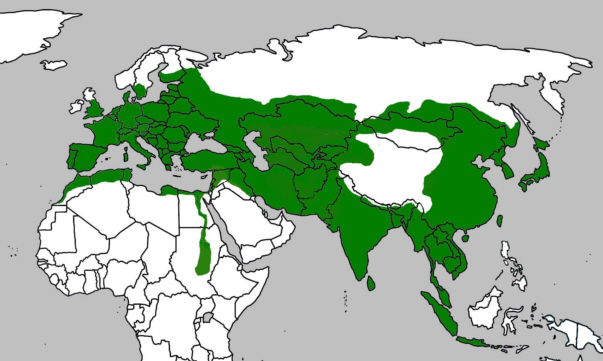
Abb.: Ursprünglicher Lebensraum des Wildschweins
[Bildquelle: Altaileopard / Wikipedia. -- Public domain]
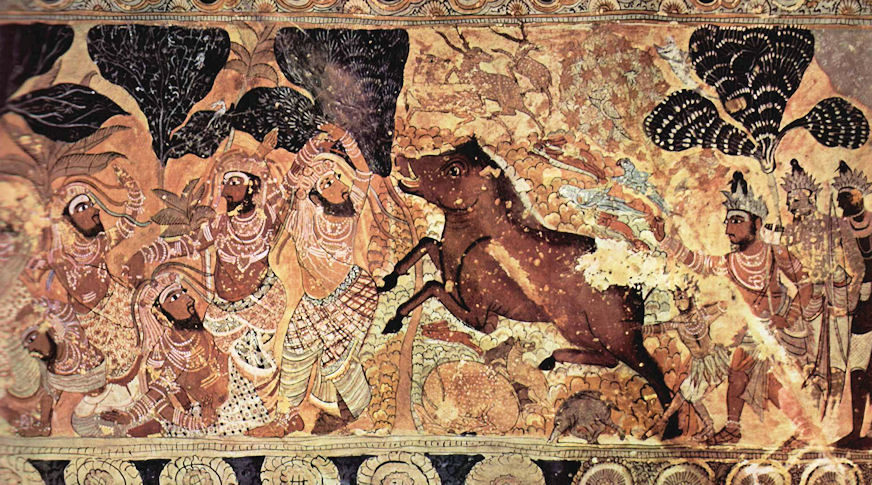
Abb.: Wildschweinjagd, Lepākshī-Tempel, Hindupur -
హిందూపురము, Andhra Pradesh, um 1540
"The wild hog is found throughout India, from the level of the sea to 12,000 feet of elevation, wherever there is sufficient shelter either of long grass, low jungle, or forest. It is very numerous in some parts, and does much damage to various crops. It associates in more or less numerous herds, called "sounder" technically, in sporting language in the Deccan, but isolated individuals are frequently met with, especially in long grass. Where this forms their chief shelter, they construct a sort of rude abode by cutting a lot of grass and spreading it out carefully on the ground. They then creep under this and raise it up to the proper height, and they remain in these lairs during the day, which afford a good shelter from the heat of the sun. I have seen numerous lairs of this description in various parts of Bengal, and often turned the hogs out of them. They travel great distances for their food in some parts of the country, and the early traveller in Nagpore and other parts, often sees a herd returning to their abode in the jungle an hour or so before sunrise. The root of a particular kind of sedge (Carex) is much sought for by wild hogs, and the edges of tanks and j heels may be seen covered with their excavations. Though in general almost entirely vegetable-feeders, at times a somewhat carnivorous habit has been observed. Wild pigs have been detected feeding on the carcase of a dead elephant in Southern India.
Spearing the wild boar is one of the favourite sports of India wherever it can be pursued, and is one of the most exciting pursuits, the dash of danger intermingled with the excitement of the chase, giving it a zest wanting in fox-hunting ; and the greater address and personal skill required giving it also the palm over tiger-shooting. The speed of the wild hog for a short distance must be tried on a good horse before it can be realized. In Madras and Bombay a long spear is used lancewise, but in Bengal a short leaden-topped jobbing spear is preferred. Now and then, as before stated, even the tiger has fallen a victim to the impetuous dash of the wild boar, and the sudden onslaught of a wounded hog when brought to bay, occasionally proves too speedy to be avoided even by a timorous and active horse.
Wild pigs are found over great part of Asia and the North of Africa, as well as in Europe, but recent information is required on the particular races inhabiting such extensive areas."
[Quelle: Jerdon, Thomas Claverhill <1811-1872>: The mammals of India : a natural history of all the animals known to inhabit continental India. -- London, 1874. -- S. 242f.]
Sus salvanius Hodgson, 1847 - Zwergwildschwein - Pygmy hog
Körperlänge: 50 - 70 cm
Gewicht: 6 - 9 kg
Lebensraum: Assam an Grenze zu Bhutan
Noch in Freiheit lebende Individuen: 250 - 300
Lebt in Gruppen von 5 - 10 Tieren
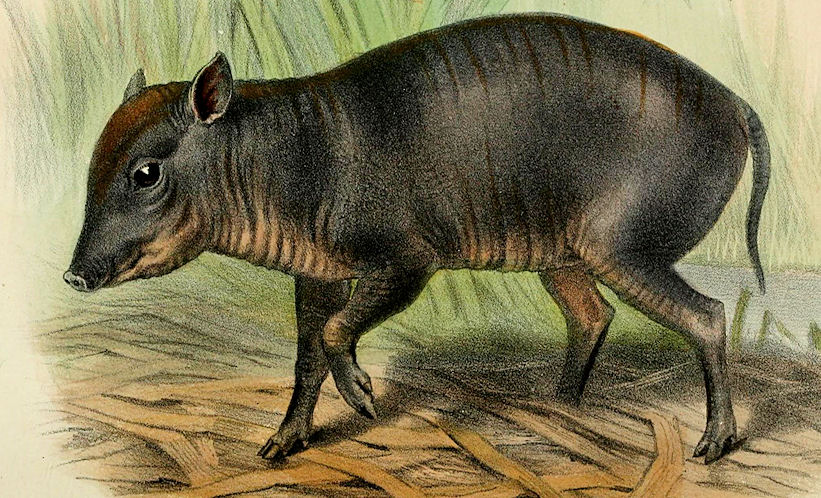
Abb.: Sus salvanius Hodgson, 1847 - Zwergwildschwein -
Pygmy hog
[Bildquelle: Proceedings of the Zoological Society of London, 1883. -- Nach S.
462]
"The Pigmy Hog is found in the Nepal and Sikim Terai, probably extending into Assam and Bhotan, but it is rare and with difficulty procurable. Mr. Hodgson had long heard of its existence before he got a single specimen. It is exclusively confined to the deep recesses of the primaeval forests. The full-grown males live constantly with the herd, which consists of from five to twenty individuals, and are its habitual and resolute defenders against harm. They eat roots, bulbs, &c., but also birds' eggs, insects, and reptiles. The female has a litter of three to four young ones.
The above account is taken entirely from Mr. Hodgson's descriptions. I endeavoured in vain to procure a specimen from the Sikim Terai whilst at Darjeeling."
[Quelle: Jerdon, Thomas Claverhill <1811-1872>: The mammals of India : a natural history of all the animals known to inhabit continental India. -- London, 1874. -- S. 244.]
Erläuterungen:
Siehe:
Carakasaṃhitā: Ausgewählte Texte aus der Carakasaṃhitā / übersetzt und erläutert von Alois Payer <1944 - >. -- Anhang B: Tierbeschreibungen. -- Sus scrofa cristatus. -- URL: http://www.payer.de/ayurveda/tiere/sus_scrofa_cristatus.htm
2.9.4.1. Varāha-Avatāra
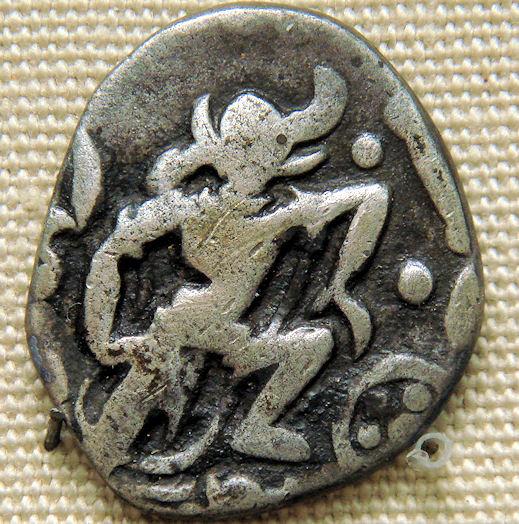
Abb.: Varāha-Avatāra, Pratihara-Münze, 850-900
n.
Chr.
[Bildquelle: PHGCOM / Wikipedia. -- GNU FDLicense]
"3. Varāha. The boar. The old legend of the Brāhmaṇas concerning the boar which raised the earth from the waters has been appropriated to Vishṇu. A demon named Hiraṇyāksha had dragged the earth to the bottom of the sea. To recover it Vishṇu assumed the form of a boar, and after a contest of a thousand years he slew the demon and raised up the earth."
[Quelle: Dowson, John <1820-1881>: A classical dictionary of Hindu mythology and religion, geography, history, and literature. -- London, Trübner, 1879. -- s.v. Avatara]
2.9.4.2. Varāhī - eine Mātṛkā
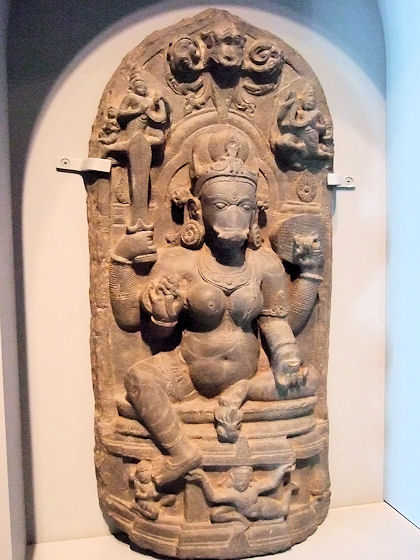
Abb.: Varāhī, Bihar, 1000/1100 n. Chr.
[Bildquelle:
Mary Harrsch. --
http://www.flickr.com/photos/44124324682@N01/2417136050. -- Zugriff am
2011-01-09. --
Creative Commons Lizenz (Namensnennung, share alike)]
"Varahi (Sanskrit: वाराही, Vārāhī) is one of the Matrikas, a group of seven or eight mother goddesses in the Hindu religion. With the head of a sow, Varahi is the shakti (feminine energy, or sometimes, consort) of Varaha, the boar avatar of the god Vishnu. In Nepal, she is called Barahi. Varahi is worshipped by all the three major schools of Hinduism: Shaktism (goddess worship); Shaivism (followers of the god Shiva); and Vaishnavism (devotion to Vishnu). She is usually worshipped at night, and according to secretive Vamamarga Tantric practices."
[Quelle: http://en.wikipedia.org/wiki/Varahi. -- Zugriff am 2011-01-09]
2.9.5. Affen
| 3. kapi-plavaṃga-plavaga-śākhāmṛga-valīmukhāḥ markaṭo vānaraḥ kīśo vanaukā atha bhalluke कपि-प्लवंग-प्लवग-शाखामृग-वलीमुखाः । [Bezeichnungen für
Affe:] |
Colebrooke (1807): "A monkey or ape."
1 प्लवंग - plavaṃga m.: der einen schwimmenden Gang hat, der einen geneigten Gang hat
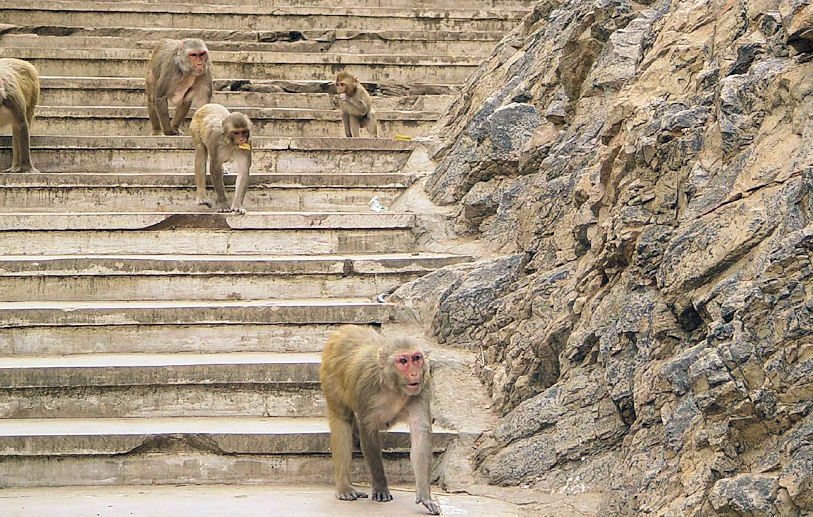
Abb.: प्लवंगः । Tempeltreppe,
Indien
[Bildquelle:
Peter
Garnhum. --
http://www.flickr.com/photos/petergarnhum/123067644/. -- Zugriff
am 2011-01-15. --
Creative Commons Lizenz (Namensnennung, keine kommerzielle
Nutzung)]
2 शाखामृग - śākhāmṛga m.: Zweig-Tier, in den Zweigen (sich aufhaltendes) Tier
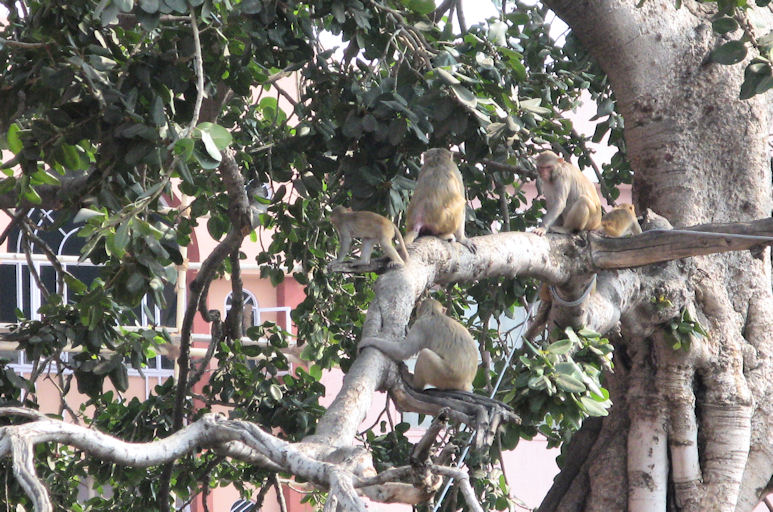
Abb.: शाखामृगः । Jaipur -
जयपुर, Rajasthan
[Bildquelle: CHRISTOPHER MACSURAK. --
http://www.flickr.com/photos/macsurak/2124971381/. -- Zugriff am
2011-01-15. --
Creative Commons Lizenz (Namensnennung)]
3 वलीमुख - valīmukha m.: der ein runzeliges Gesicht hat
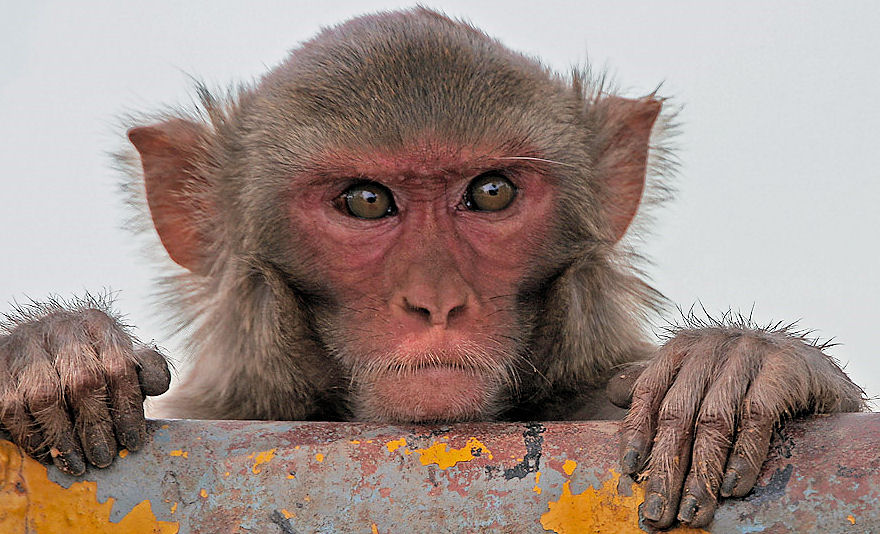
Abb.: वलीमुखः । Macaca mulatta Zimmermann 1780 - Rhesusaffe - Rhesus Monkey,
Kinnerasani Wildlife Sanctuary, Andhra Pradesh
[Bildquelle: J. M. Garg / Wikimedia. -- GNU FDLicense]
4 वनौकस् - vanaukas m.: der im Wald seine Wohnung hat
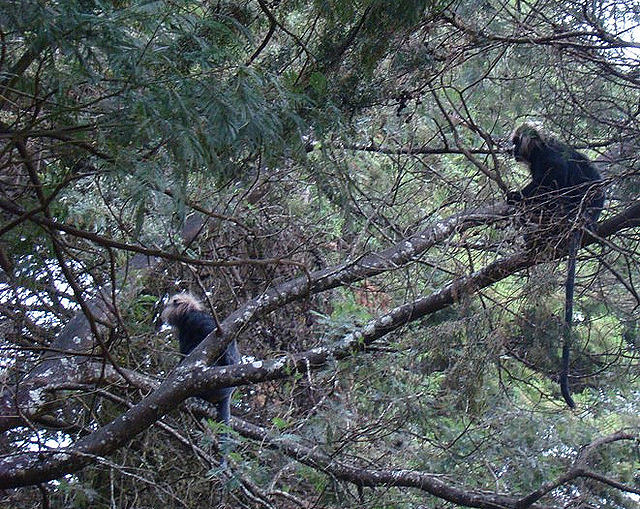
Abb.: वनौकाः । Nilgiri Biosphere
Reserve - நீலகிரி பல்லுயிர் வலயம், Tamil Nadu
[Bildquelle: snonymousG. --
http://www.flickr.com/photos/thenilgiris/4232717747/. -- Zugriff
am 2011-01-15. --
Creative Commons Lizenz (Namensnennung, keine kommerzielle
Nutzung)]
In Indien kommen vor allem folgende Affenarten vor:
- Macaca sp. - Makaken - Macaques
- Macaca silenus Linnaeus, 1758 - Bartafffe - Lion-tailes Macaque (Südwest-Indien)
- Macaca nemestrina Linnaeus, 1766 - Südlicher Schweinsaffe - Pig-tailed Macaque (Assam)
- Macaca mulatta Zimmermann, 1780 - Rhesusaffe - Rhesus Monkey (Großteil des Subkontinents)
- Macaca sinica Linnaeus, 1771 - Ceylon-Hutaffe - Toque Macaque (Sri Lanka)
- Macaca radiata E. Geoffroy, 1812 - Indischer Hutaffe - Bonnet Macaque (Subkontinent)
- Macaca assamensis M'Clelland, 1840 - Assam-Makak - Assam Macaque (Himalaya und Vorgebirge)
- Macaca arctoides I. Geoffroy, 1831- Bären-Makak /
Stummelschwanz-Makak - Stump-tailed Macaque (Brahmaputratal)
- Semnopithecus entellus Dufresne, 1797 - Hanuman-Langur - Northern Plains Gray Langur (Hanuman Langur) (ganzer Subkontinent von Südtibet abwärts)
- Trachypithecus sp. - Haubenlanguren - Brown-ridged Langurs / Leaf Monkeys
- Trachypithecus vetulus Erxleben, 1777 - Weißbart-Langur - Purple-faced Langur (Sri Lanka)
- Trachypithecus johnii J. Fischer, 1829 - Nilgiri-Langur - Nilgiri Langur (Südwestindien)
- Trachypithecus geei Khajuria, 1956 - Goldlangur - Gee's Golden Langur (Nepal, Nordostindien)
- Trachypithecus pileatus Blyth, 1843 - Kappenlangur - Capped Langur (Assam, Bangladesh)
- Bunopithecus sp. - Gibbons
- Bunopithecus hoolock Harlan, 1834 - Weißbrauen-Gibbon / Hulock - Hoolock Gibbon (Nordostindien südlich des Brahmaputra)
2.9.5.1. Makaken
Macaca silenus Linnaeus, 1758 - Bartafffe - Lion-tailes Macaque
Körperlänge: 46 - 60 cm
Gewicht: 6 - 8 kg
Lebensraum: West-Ghats und angrenzende Berge in Karnataka, Kerala und Tamil Nadu
Noch in Freiheit lebende Individuen: ca. 3000 - 4000
Lebt in Gruppen von 7 - 40
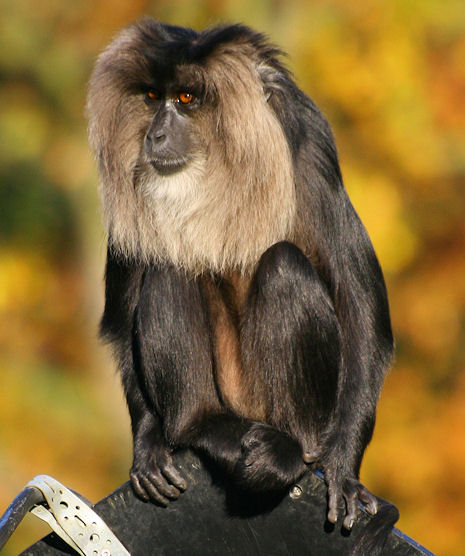
Abb.: Macaca silenus Linnaeus 1758 - Bartafffe - Liontail Macaque, Zoo
[Bildquelle: Wer-Al Zwowe / Wikipedia. -- Public domain]
"This well-known monkey has been bandied about in several genera, some making him a Papio, others a Cynocephalus, and many a Macacus ; whilst Lesson, followed by Gray, places him as a distinct genus. It certainly has the baboon-like characters, viz., the stronger teeth, more lengthened face, and the tufted tail more strongly marked than others. Till lately it has been looked upon in Europe as a native of Ceylon as well as of the Southern parts of India, and the name Wanderoo, applied to it by Buffon, is properly the Ceylonese name of the Langurs ; but Templeton and Layard pointed out that it was never found on that island. It is a native of the more elevated forests of the Western Ghats of India from N. L. 14° to the extreme South, but most abundant in Cochin and Travancore. It is said to occur still further North up to Goa, N. L. 15°, but I have no authentic information of its occurrence so high. It frequents the most dense and unfrequented parts of the forest, always, as far as I have observed it, at a considerable elevation, and I had often traversed the Malabar forests before I first fell in with it. This was at the top of the Cotiaddy pass, leading from Malabar into the Wynaad. I have since met with it in several other localities, but always near the crest of the Ghats. It occurs in troops of from twelve to twenty or more, and those I observed were exceedingly shy and wary. It is not, to my knowledge, often caught in the Wynaad, and most of the individuals seen in captivity appear to be taken in Travancore. In its nature it is more sulky and savage than the next species, and is with difficulty taught to perform any feats of agility or mimicry."
[Quelle: Jerdon, Thomas Claverhill <1811-1872>: The mammals of India : a natural history of all the animals known to inhabit continental India. -- London, 1874. -- S. 10f.]
Macaca nemestrina Linnaeus, 1766 - Südlicher Schweinsaffe - Pig-tailed Macaque
Körperlänge: 43 - 60 cm
Gewicht: 4 - 16 kg
Lebensraum: Nordostindien südlich des Brahmaputra, bis 2000 m ü. M.
Noch in Freiheit lebende Individuen: unbekannt
Lebt in kleinen Gruppen
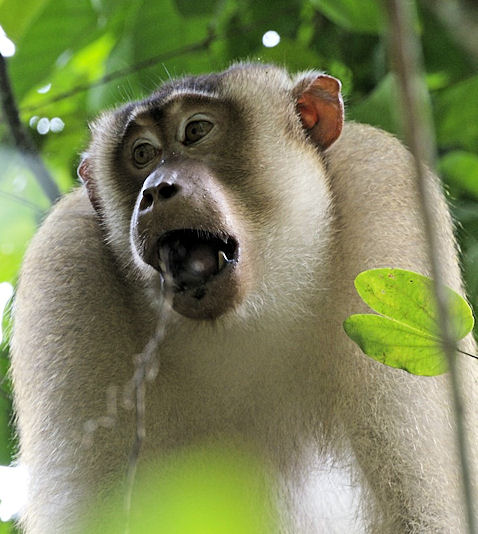
Abb.: Macaca nemestrina Linnaeus 1766 - Südlicher Schweinsaffe - Pigtail
Macaque, Panti Forest, Johor, Malaysia
[Bildquelle: Lip Kee. --
http://www.flickr.com/photos/lipkee/3074074917/. -- Zugriff am 2010-12-10.
-- Creative Commons
Lizenz (Namensnennung, share alike)
Macaca mulatta Zimmermann, 1780 - Rhesusaffe - Rhesus Monkey
Häufigste Affenart Nordindiens
Körperlänge: 47 - 63 cm
Gewicht: 5 - 11 kg
Lebensraum: ganz Nord und Nordostindien, außer Himalaya-Hochgebirge und Wüsten,
bis 2400 m ü. M.; Dörfer und Städte, wo sie oft in den Häusern auf Raubzüge
gehen
Noch in Freiheit lebende Individuen: unbekannt, sehr viele
Lebt in Gruppen von 5 - 50 Tieren
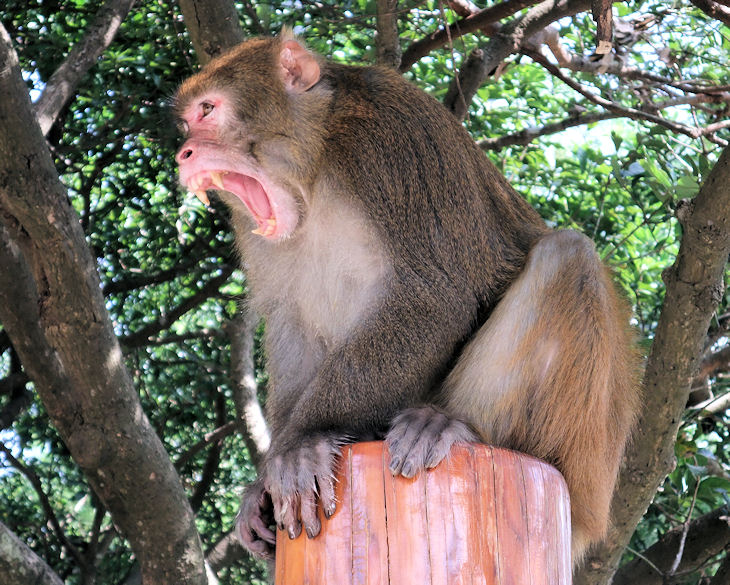
Abb.: Macaca mulatta Zimmermann 1780 - Rhesusaffe - Rhesus Monkey
[Bildquelle: Minghong / Wikimedia. -- GNU FDLicense]
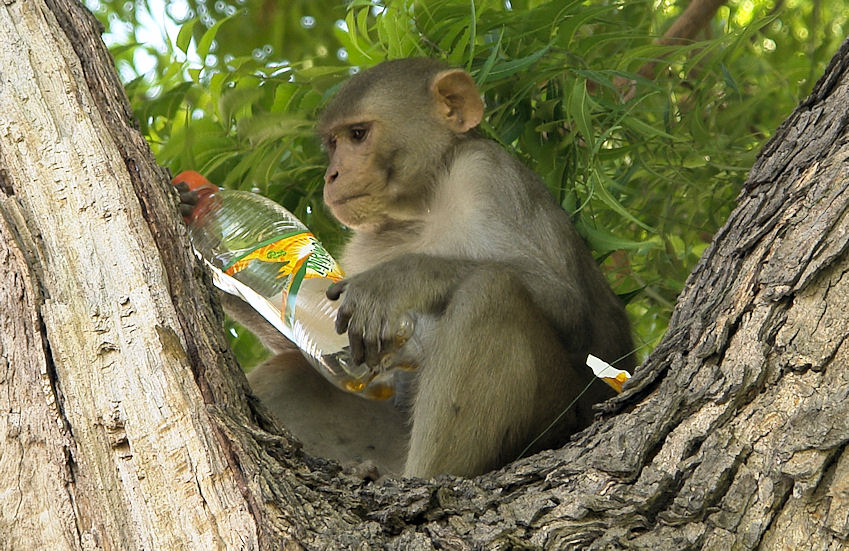
Abb.: Macaca mulatta Zimmermann 1780 - Rhesusaffe - Rhesus Monkey, Red
Fort - आगरा क़िला, Agra -
आगरा -
آ گرہ, UP
[Bildquelle: Yann / Wikimedia. -- GNU FDLicense]
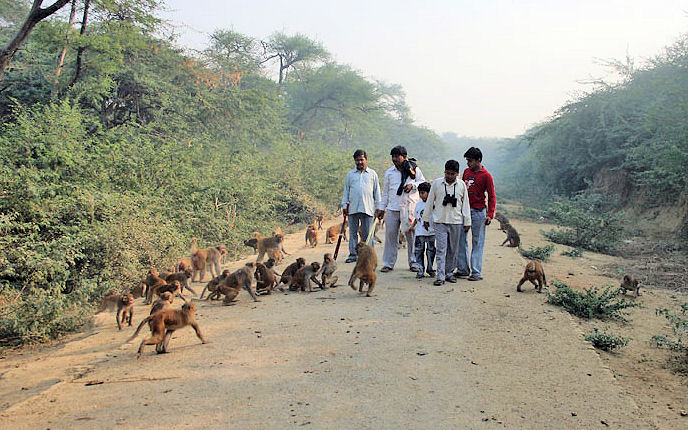
Abb.: Macaca mulatta Zimmermann 1780 - Rhesusaffe - Rhesus Monkey, Hodal
- होडाल, Haryana
[Bildquelle: J. M. Garg / Wikimedia. -- GNU FDLicense]
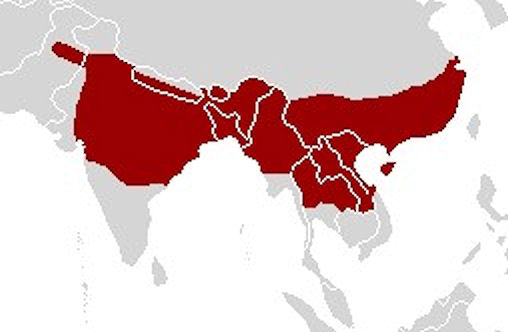
Abb.: Heutiger Lebensraum von Macaca mulatta Zimmermann 1780 - Rhesusaffe
- Rhesus Monkey
[Bildquelle: Esculapio / Wikipedia. -- GNU FDLicense]
"This is the common monkey of all Northern India, extending South to about N. L. 18° or 19°. I have observed it in Goomsoor and near Nagpore, but not further South. It extends into the Himalayas up to at least 4,000 or 5,000 feet of elevation. It frequents alike forest and groves in the open country, and may be seen in abundance in many large towns and villages in Northern India. It is very commonly tamed, and made to exhibit various feats of agility. When old, the males especially become somewhat savage, and less tractable than younger individuals."
[Quelle: Jerdon, Thomas Claverhill <1811-1872>: The mammals of India : a natural history of all the animals known to inhabit continental India. -- London, 1874. -- S. 11.]
Macaca sinica Linnaeus, 1771 - Ceylon-Hutaffe - Toque Macaque
Körperlänge: 35 - 55 cm
Gewicht: bis 8,5 kg
Lebensraum: Sri Lanka, bis 2200 m ü. M.
Noch in Freiheit lebende Individuen:
Lebt in Gruppen von bis zu 40 Tieren
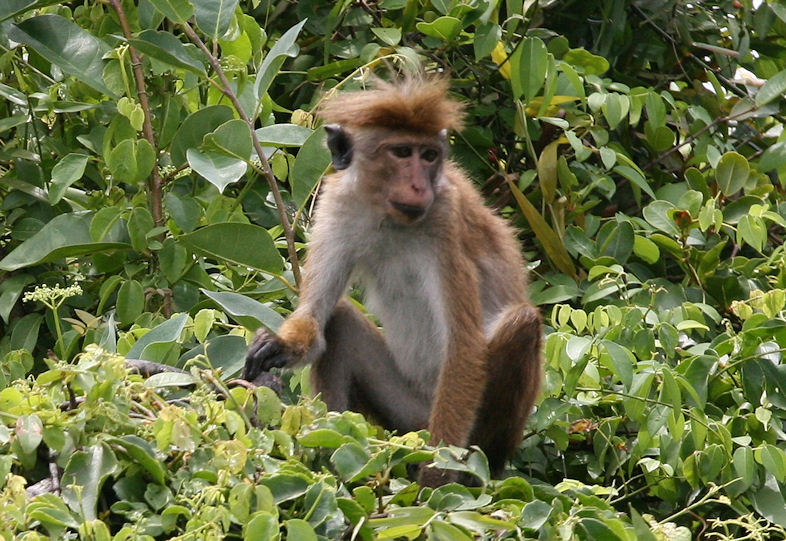
Abb.: Macaca sinica Linnaeus 1771 - Ceylon-Hutaffe - Toque Macaque,
Muthurajawela Reserve bei Negombo - මීගමුව, Sri Lanka
[Bildquelle: Arthur Chapman. --
http://www.flickr.com/photos/32005048@N06/3040808426. -- Zugriff am
2010-12-10. --
Creative Commons Lizenz (Namensnennung, keine kommerzielle Nutzung, share
alike)]
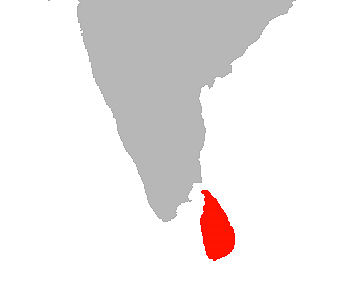
Abb.: Heutiger Lebensraum von Macaca sinica Linnaeus 1771 -
Ceylon-Hutaffe - Toque Macaque
[Bildquelle: Christophe Chauvin / Wikipedia. -- Public domain]
Macaca radiata E. Geoffroy, 1812 - Indischer Hutaffe - Bonnet Macaque
Der häufigste Affe Südindiens in menschlicher Umgebung
Körperlänge: 35 - 65 cm
Gewicht: 4 - 9 kg
Lebensraum: Südindien bis Godavari, Dörfer und Städte
Noch in Freiheit lebende Individuen: unbekannt, sehr zahlreich
Lebt in Gruppen von 20 - 30 Tieren
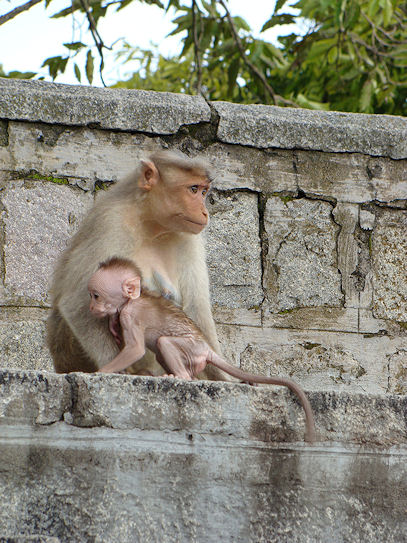
Abb.: Macaca radiata E. Geoffroy 1812 - Indischer Hutaffe - Bonnet
Macaque, Chamundi Hills, Karnataka
[Bildquelle: Peter Maas. --
http://www.flickr.com/photos/31038052@N00/2746840058. -- Zugriff am
2010-12-10. --
Creative Commons Lizenz (Namensnennung, keine kommerzielle Nutzung, keine
Bearbeitung)
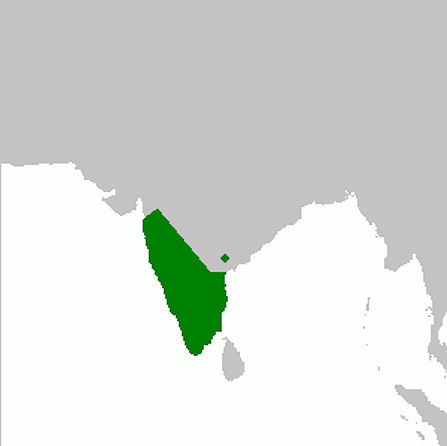
Abb.: Heutiges Verbreitunsgebiet von Macaca radiata E. Geoffroy 1812 -
Indischer Hutaffe - Bonnet Macaque
[Bildquelle: L. Shyamal / Wikipedia. -- Public domain]
"This monkey is found over all the Southern parts of India, extending North to N. L. 18°, or thereabouts, where it is replaced by Inuus rhesus. "It abounds," says Mr. Elliot, "over all this portion of country, sometimes inhabiting the wildest jungles, and at others living in populous towns, and carrying off fruit and grain from the shops of the dealers with the greatest coolness and address."
It is the monkey most commonly found in menageries, and led about to show various tricks and feats of agility. It is certainly the most inquisitive and mischievous of its tribe, and its powers of mimicry are surpassed by none. With age it becomes more sullen and less amenable to discipline."
[Quelle: Jerdon, Thomas Claverhill <1811-1872>: The mammals of India : a natural history of all the animals known to inhabit continental India. -- London, 1874. -- S. 12f.]
Macaca assamensis M'Clelland, 1840 - Assam-Makak - Assam Macaque
Körperlänge: 44 - 68 cm
Gewicht: 4,6 - 12 kg
Lebensraum: Nordostindien, außer Tripura; bis 3000 m ü. M.; plündert oft
landwirtschaftliche Felder und wird von Dorfbewohnern deshalb gejagt
Noch in Freiheit lebende Individuen: ca. 25000
Lebt in Gruppen von 15 - 20 Tieren
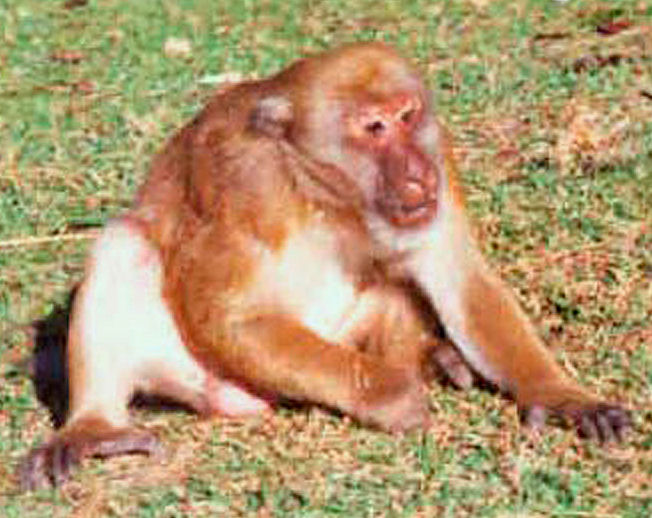
Abb.: Macaca assamensis McClelland 1840- Assam-Makak - Assam Macaque
[Bildquelle: M. Cooper / Wikimedia. -- Public domain]
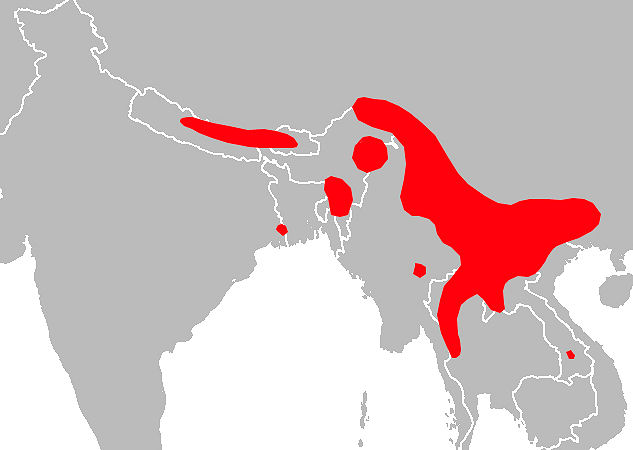
Abb.: Heutige Lebensräume von Macaca assamensis McClelland 1840-
Assam-Makak - Assam Macaque
[Bildquelle: Christophe Chauvin / Wikipedia. -- Public domain]
Macaca arctoides I. Geoffroy, 1831- Bären-Makak / Stummelschwanz-Makak - Stump-tailed Macaque
Körperlänge: 50 - 70 cm
Gewicht: 6 - 18 kg
Lebensraum: Nordostindien südlich des Brahmaputra; bis 2400 m ü. M.
Noch in Freiheit lebende Individuen: unbekannt
Lebt in Gruppen von 12 - 65 Tieren
Lärmig und furchtlos. Stinkt.
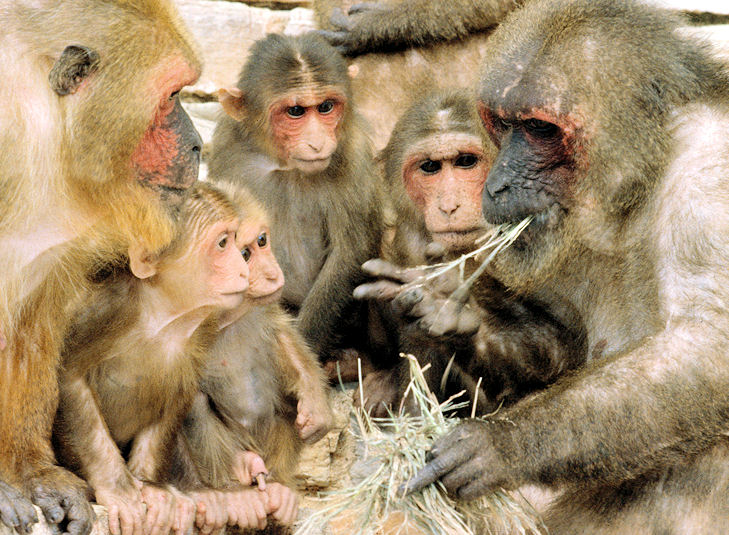
Abb.: Macaca arctoides I. Geoffroy 1831- Bären-Makak /
Stummelschwanz-Makak - Stump-tailed Macaque
[Bildquelle: Frans de Waal / Wikimedia. --
Creative Commons
Lizenz (Namensnennung)]
2.9.5.2. Semnopithecus entellus Dufresne, 1797 - Hanuman-Langur - Northern Plains Gray Langur (Hanuman Langur)
Häufigste Langurenart in Indien. Verschiedene Rassen. Gilt bei meisten Hindus als heiliges Tier (-> Gott Hanumān, siehe unten!)
Körperlänge: 60 - 75 cm
Gewicht: 16 - 21 kg (westlicher Himalaya); 9 - 16 kg (Subkontinent)
Lebensraum: überall, außer im Hochgebirge (über 3000 m ü. M.) und in Wüsten;
auch menschliche Siedlungen; bei Tempeln
Noch in Freiheit lebende Individuen:
Lebt in
Lebt oft in Gemeinschaft mit Axis axis Erxleben, 1777 - Axishirsch - Chital / Spotted Deer. Beide warnen sich gegenseitig vor Raubtieren. Der Chital frisst Blätter und Früchte, die Hanuman-Languren von den Bäumen werfen.
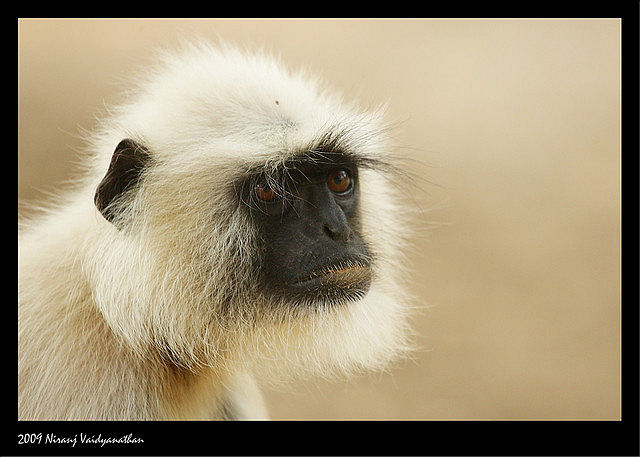
Abb.: Semnopithecus entellus Dufresne 1797 - Hanuman-Langur -
Hanuman Langur, Kanha National Park - कान्हा राष्ट्रीय उद्यान, Madhya Pradesh
[Bildquelle:
Niranj Vaidyanathan. --
http://www.flickr.com/photos/jnarin/4288917543/. -- Zugriff am 2010-12-10.
-- Creative Commons
Lizenz (Namensnennung, keine kommerzielle Nutzung, keine Bearbeitung)]
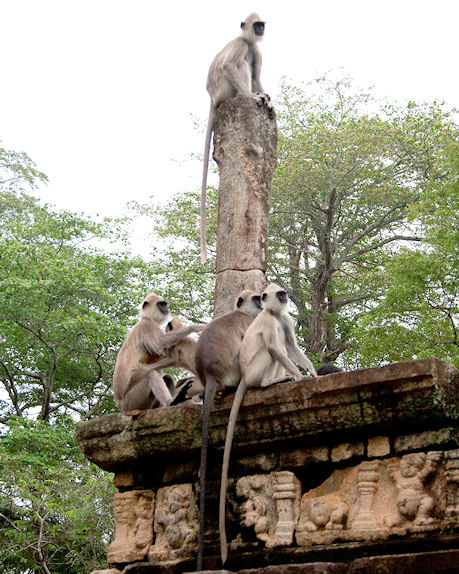
Abb.: Semnopithecus entellus Dufresne 1797 - Hanuman-Langur -
Hanuman Langur, Polonnaruwa - පොළොන්නරුව, Sri Lanka
[Bildquelle: Graham Racher. --
http://www.flickr.com/photos/wanderlustg/4239699231/. -- Zugriff am
2010-12-10. -- Creative
Commons Lizenz (Namensnennung, share alike)]
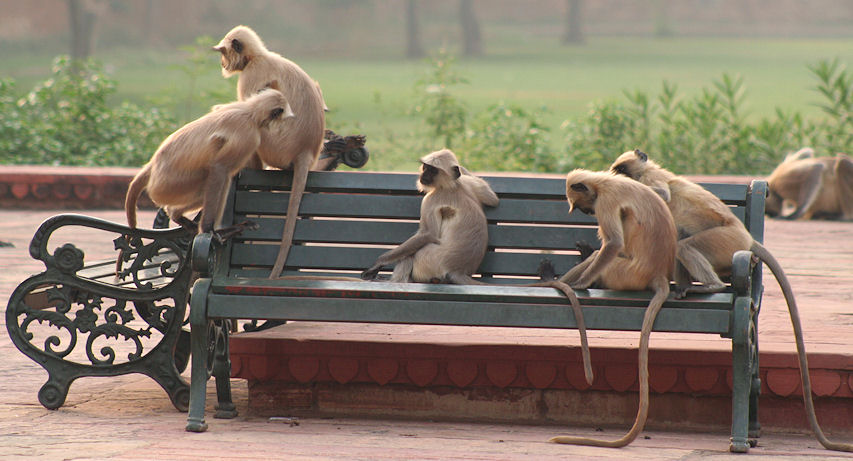
Abb.: Semnopithecus entellus Dufresne 1797 -
Hanuman-Langur - Hanuman Langur, Agra - आगरा
-
آ گرہ, UP
[Bildquelle: John Haslam. --
http://www.flickr.com/photos/43145783@N00/3324056828. -- Zugriff am
2010-12-10. -- Creative Commons Lizenz (Namensnennung)]
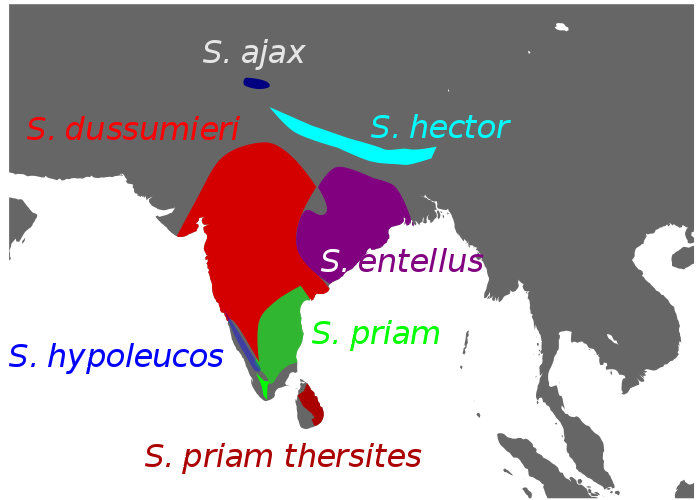
Abb.: Verbreitung von der Unterarten von
Semnopithecus, den Hanuman-Languren
[Bildquelle: L. Shyamal / Wikipedia. -- Public domain]
"This is the common Langur or Hanumān of Bengal and Central India. Buchanan Hamilton says that it is not found north of the Ganges, and that even south of that river it is rare in certain parts that would appear suitable for it, as at Rajmahal. Mr. Blyth states that he has never seen it wild east of the Hoogly, but that it extends up the right bank of that river and the Ganges, and thence to Cuttack and Central India. It is uncertain how far it extends southwards and westwards, and one variety or race from the south was named as distinct by Elliot. My impression of the Langur found in the Deccan is, that it had less black on the hands and feet, and was of a decidedly more ashy hue than the Bengal monkey, thus corresponding with part of Horsfield's description of entellus ; and it is still a desideratum to define the geographic boundaries of Presbytis entellus and P. priamus.
This monkey, like all others of the genus, abounds most in forests and highly-wooded districts, but it not unfrequently takes up its abode in large groves near towns and villages, and occasionally enters towns and plunders the shops of the grain-dealers with impunity ; for Hindoos, in the North of India especially, deem it sacrilege to kill one. In some parts of the country, indeed, it would hardly be safe to do so, though Mr. Blyth records that some villagers along the Hoogly are not at all sorry to see one shot by a European.
The Entellus feeds on grain, fruit, pods of various trees, especially of leguminosae, and also of leaves and young shoots. It is said that, the males live apart from the females, who have only one or two old males with each colony. These are said to drive away or kill, if they can, the younger males, whom, however, the females protect, all assisting. At a particular season all the males sally forth to the nearest colony of females and a regular fight ensues, at the end of which the vanquished males receive charge of the young ones of that sex from the females, and retire to some neighbouring jungle. This account was partly confirmed by Blyth, who found in one locality males alone, of all ages ; and in another, chiefly females. The female has usually only one young one, occasionally, it is said, twins.
Hanumān, the meaning of which is long-jaw, was one of the monkeys of the monkey kingdom of Southern India, who aided Rāma in his conquest of Ceylon, by forming a bridge of rocks opposite Manar, and greatly distinguished himself. His figure is often found in Hindoo temples in the guise of a man, with a black monkey face, and a long tail : he is not worshipped, only greatly reverenced. In some temples in the West of India, this monkey is regularly fed by the priests.
In confinement the Entellus monkey is quiet, sedate, and indolent."
[Quelle: Jerdon, Thomas Claverhill <1811-1872>: The mammals of India : a natural history of all the animals known to inhabit continental India. -- London, 1874. -- S. 4ff.]
2.9.5.2.1. Hanumān, der göttliche Affe
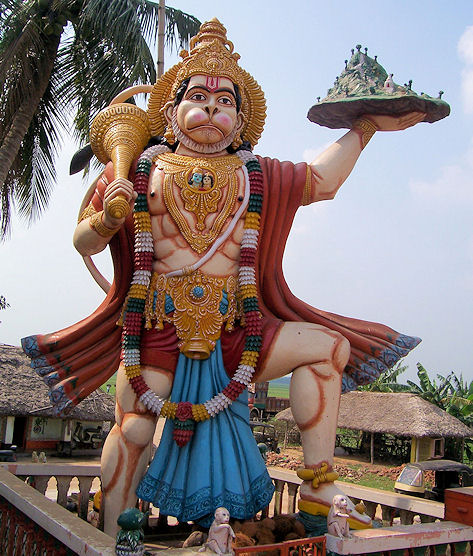
Abb.: Hanumān-Statue, Haladiagada, Kendrapara -
କେନ୍ଦ୍ରାପଡା, Orissa
[Bildquelle: Sujit kumar / Wikimedia. -- GNU FDLicense]
"HANUMĀN, HANUMAT, HANUMAT. A celebrated monkey chief. He was son of Pavana, 'the wind,' by Anjanā, wife of a monkey named Kesarī. He was able to fly, and is a conspicuous figure in the Rāmāyaṇa. He and the other monkeys who assisted Rāma in his war against Rāvaṇa were of divine origin, and their powers were superhuman. Hanumān jumped from India to Ceylon in one bound ; he tore up trees, carried away the Himalayas, seized the clouds, and performed many other wonderful exploits. (See Surasā.) His form is "as vast as a mountain and as tall as a gigantic tower. His complexion is yellow and glowing like molten gold. His face is as red as the brightest ruby ; while his enormous tail spreads out to an interminable length. He stands on a lofty rock and roars like thunder. He leaps into the air, and flies among the clouds with a rushing noise, whilst the ocean waves are roaring and splashing below." In one of his fights with Rāvaṇa and the Rākshasas, they greased his tail and set it on fire, but to their own great injury, for with it he burnt down their capital city, Lankā. This exploit obtained for him the name Lankā-dāhī. His services to Rāma were great and many. He acted as his spy, and fought most valiantly. He flew to the Himalayas, from whence he brought medicinal herbs with which he restored the wounded, and he killed the monster Kāla-nemi, and thousands of Gandharvas who assailed him. He accompanied Rāma on his return to Ayodhyā, and there he received from him the reward of perpetual life and youth. The exploits of Hanuman are favourite topics among Hindus from childhood to age, and paintings of them are common. He is called Marut-putra, and he has the patronymics Ānili, Māruti, &c., and the metronymic Ānjaneya. He is also Yoga-chara, from his power in magic or in the healing art, and Rajata-dyuti, 'the brilliant.' Among his other accomplishments, Hanumat was a grammarian ; and the Rāmāyaṇa says, "The chief of monkeys is perfect; no one equals him in the śāstras, in learning, and in ascertaining the sense of the scriptures [or in moving at will]. In all sciences, in the rules of austerity, he rivals the preceptor of the gods. ... It is well known that Hanumat was the ninth author of grammar." Muir, iv. 490." [Quelle: Dowson, John <1820-1881>: A classical dictionary of Hindu mythology and religion, geography, history, and literature. -- London, Trübner, 1879. -- s.v. ]
2.9.5.3. Haubenlanguren
Trachypithecus vetulus Erxleben, 1777 - Weißbart-Langur - Purple-faced Langur
Körperlänge: 45 - 65 cm, Schwanz 62 - 85 cm
Gewicht: 6 - 8 kg
Lebensraum: Sri Lanka, bis 2000 m ü. M.
Noch in Freiheit lebende Individuen: unbekannt
Lebt in Haremsgruppen mit 1 - 7 Weibchen, Junggesellengruppen von 2 - 14 Tieren
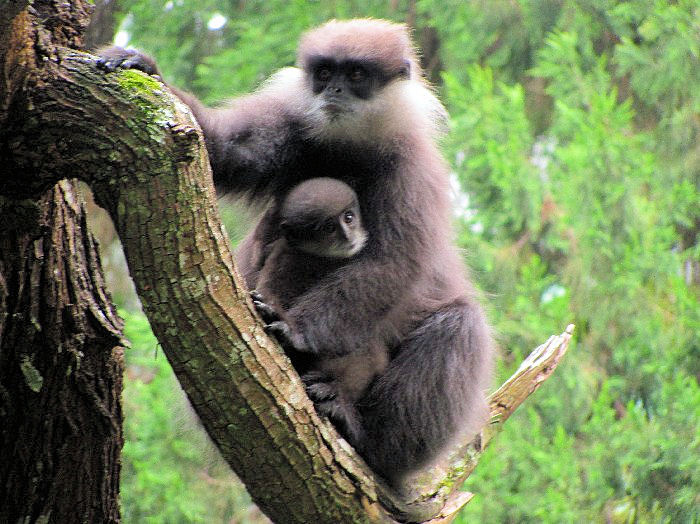
Abb.: Trachypithecus vetulus Erxleben, 1777 - Weißbart-Langur -
Purple-faced Langur, Hakgala, Sri Lanka
[Bildquelle: Lärchenholz / Wikipedia. -- Public domain]
Trachypithecus johnii
J. Fischer, 1829 - Nilgiri-Langur - Nilgiri LangurHäufigster Regenwald-Affe der West-Ghats.
Körperlänge: 60 - 80 cm
Gewicht: 11 - 14 kg
Lebensraum: West-Ghats, Palni Hills (பழனி மலை),
Anamalai Hills (ஆனைமலை,
ആനമല). Vorwiegend Regenwald, bei
Pflanzungen
Noch in Freiheit lebende Individuen: ca. 10.000
Lebt in Gruppen von 8 - 15 Tieren
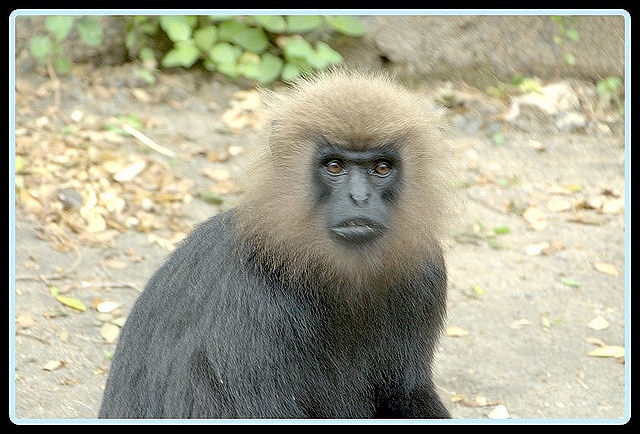
Abb.: Trachypithecus johnii J. Fischer 1829- Nilgiri-Langur - Nilgiri
Langur, Indira Gandhi Wildlife Sanctuary & National Park, Tamil Nadu
[Bildquelle: cprogrammer. --
http://www.flickr.com/photos/43383965@N00/83800374/. -- Zugriff am
2010-12-10. -- Creative
Commons Lizenz (Namensnennung, share alike)]
"This monkey is found on the Malabar Coast, from about N. L. 14° or 15° to Cape Cormorin ; that is to say, in the provinces of South Canara, Malabar, Cochin, and Travancore. Horsfield, in his Catalogue, states it to have been found "near Madras, and also in the interior of the peninsula." This is certainly erroneous, and I do not believe that it extends beyond the limit of the forests of Malabar. It does not ascend the mountains to any great height above the sea, and I never saw it above 1,200 or 1,300 feet on the various passes that I have traversed. It certainly does not occur on the wooded table-land of the Wynaad. It is not confined to the forests, but frequents gardens and the belt of cultivated wooded land that extends all along the sea coast of Malabar.
Like others of this genus, it generally, by a noisy and alarmed chatter, gives notice of the presence of tigers, leopards, and other animals of prey. A pair that frequented my garden at Tellicherry pointed out the situation of a tiger that had come during the night. Its food is similar to that of its congeners fruit, seeds, and leaves, and it has the usual loud cry as it leaps from branch to branch. Though frequenting high trees in garden land, it is not at all familiar, like Entellus in similar spots, and rather shuns observation. It is frequently taken when young and tamed, as is mentioned by Belanger."
[Quelle: Jerdon, Thomas Claverhill <1811-1872>: The mammals of India : a natural history of all the animals known to inhabit continental India. -- London, 1874. -- S. 8.]
[Presbytis jubatus - Neelgherry Langur] "This handsome monkey is found on the Neelgherry hills, the Animallies, Pulneys, the Wynaad, and all the higher parts of the range of Ghats as low as Travancore. It does not, as far as I have observed it, descend lower than from 2,500 to 3,000 feet. It is shy and wary, and does not affect the neighbourhood of man. It is, or used to be, very abundant in the dense woods of the Neelgherries, and when they were beaten for game, these black monkeys would make their way rapidly and with loud cries to the lowest part of the shola, and thence to some neighbouring wood at a lower level. The fur is fine and glossy, and is much prized."
[Quelle: Jerdon, Thomas Claverhill <1811-1872>: The mammals of India : a natural history of all the animals known to inhabit continental India. -- London, 1874. -- S. 9.]
Trachypithecus geei
Khajuria, 1956 - Goldlangur - Gee's Golden LangurKörperlänge: 50 - 60 cm
Gewicht: 9,5 - 11 kg
Lebensraum: kleines Gebiet in Assam an Grenze zu Bhutan
Noch in Freiheit lebende Individuen: unter 1000
Lebt in Gruppen von 5 - 10 (maximal 22) Tieren
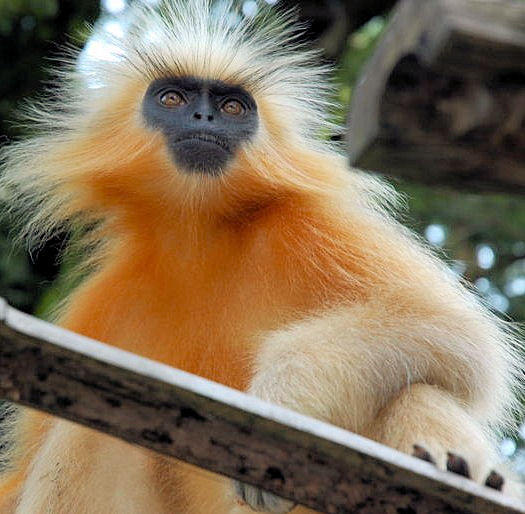
Abb.: Trachypithecus geei Khajuria 1956 - Goldlangur - Gee's Golden
Langur, Guwahati - গুৱাহাটী, Assam
[Bildquelle: Doniv79 / Wikipedia. --
Creative Commons
Lizenz (Namensnennung, share alike)]
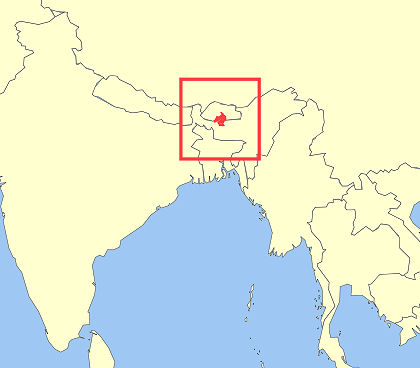
Abb.: Heutiger Lebensraum von Trachypithecus geei Khajuria 1956 -
Goldlangur - Gee's Golden Langur
[Bildquelle: Mysid & IUCN / Wikipedia. --
Creative Commons
Lizenz (Namensnennung, share alike)]
Trachypithecus pileatus
Blyth, 1843 - Kappenlangur - Capped LangurHäufigster Wald-Langur Nordostindiens. Mehrere Subspecies.
Körperlänge: 50 - 70 cm
Gewicht: 10 - 12 kg
Lebensraum: Nordostindien, bis 2000 m ü. M.
Noch in Freiheit lebende Individuen: unbekannt, nicht unhäufig
Lebt in Gruppen von 5 - 16 Tieren
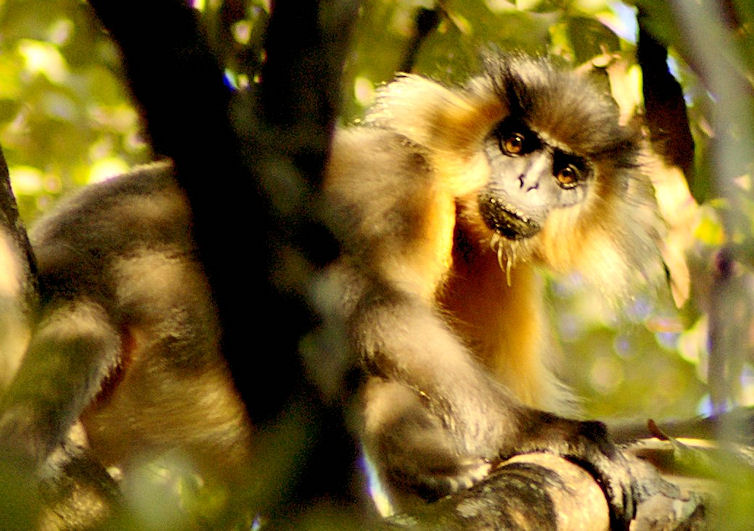
Abb.: Trachypithecus pileatus
[Bildquelle: Pankaj. -- http://www.flickr.com/photos/60466964@N00/2121706951. -- Zugriff am 2010-12-10. -- Creative Commons Lizenz (Namensnennung, share alike)]
Trachypithecus cristatus Raffles, 1821- Silberner Haubenlangur - Silvery Lutung
Körperlänge: 46 - 56 cm, Schwanz 63 - 84 cm
Gewicht: 6,6 kg (Männchen), 5,7 kg (Weibchen)
Lebensraum: östliches Nordostindien
Noch in Freiheit lebende Individuen:
Lebt in Haremsgruppen
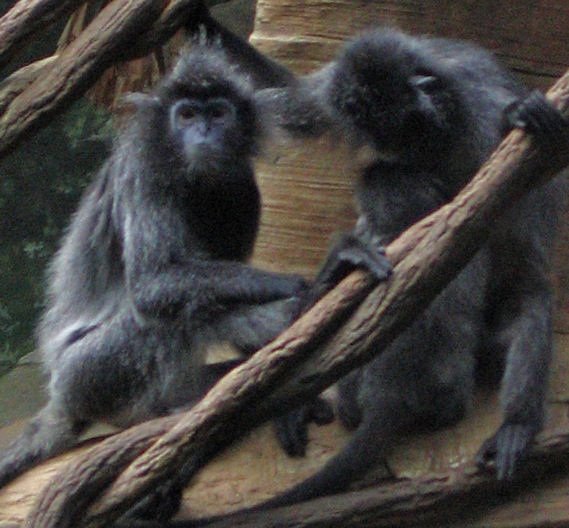
Abb.: Trachypithecus cristatus Raffles 1821- Silberner Haubenlangur
- Silvery Lutung, Zoo
[Bildquelle: Postdlf / Wikimedia. -- GNU FDLicense]
2.9.5.4. Bunopithecus hoolock Harlan, 1834 - Weißbrauen-Gibbon / Hulock - Hoolock Gibbon
Einziger indischer Menschenaffe.
Körperlänge: 90 cm
Gewicht: 6 - 8 kg
Lebensraum: Nordostindien südlich des Brahmaputra
Noch in Freiheit lebende Individuen: ca. 2.500
Lebt in Kleingruppen von 2 - 3 Tieren
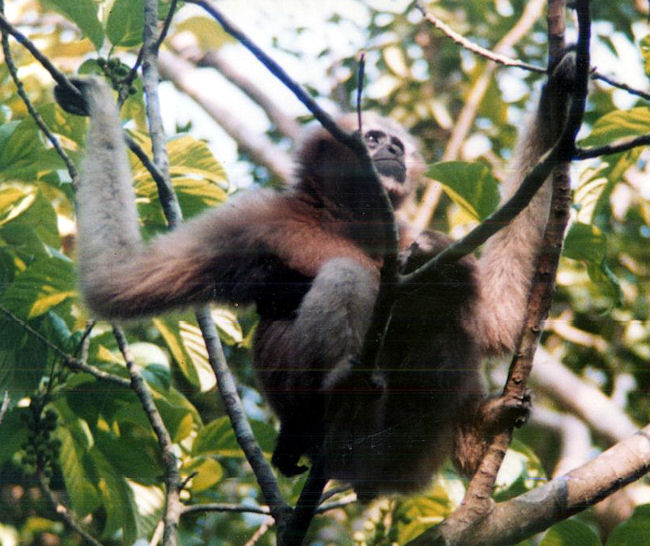
Abb.: Bunopithecus hoolock Harlan, 1834 - Weißbrauen-Gibbon /
Hulock - Hoolock Gibbon, Shrimangal, Sylhet, Bangladesh
[Bildquelle: Bhaskar Chowdhury / Wikimedia. --
Creative Commons
Lizenz (Namensnennung)]
Erläuterungen:
Siehe:
Carakasaṃhitā: Ausgewählte Texte aus der Carakasaṃhitā / übersetzt und erläutert von Alois Payer <1944 - >. -- Anhang B: Tierbeschreibungen. -- Semnopithecus sp. -- URL: http://www.payer.de/ayurveda/tiere/semnopithecus.htm
Carakasaṃhitā: Ausgewählte Texte aus der Carakasaṃhitā / übersetzt und erläutert von Alois Payer <1944 - >. -- Anhang B: Tierbeschreibungen. -- Macaca mulatta. -- URL: http://www.payer.de/ayurveda/tiere/macaca_mulatta.htm
Carakasaṃhitā: Ausgewählte Texte aus der Carakasaṃhitā / übersetzt und erläutert von Alois Payer <1944 - >. -- Anhang B: Tierbeschreibungen. -- Macaca radiata. -- URL: http://www.payer.de/ayurveda/tiere/macaca_radiata.htm
2.9.6. Bären
| 3. c./d. markaṭo vānaraḥ kīśo vanaukā atha bhalluke 4. a./b. ṛkṣāccha-bhalla-bhallūkā gaṇḍake khaḍga-khaḍginau
मर्कटो वानरः कीशो वनौका अथ भल्लुके ॥३ ख॥ Bezeichnungen für भल्लुक - bhalluka m.: Bär
|
Colebrooke (1807): "A bear."
In Indien kommen vor:
- Melursus ursinus Shaw, 1791 - Lippenbär - Sloth Bear =
Melursus ursinus Shaw, 1791 - Lippenbär - Sloth Bear = Ursus ursinus (Shaw) Krause et al., 2008 - Lippenbär - Sloth Bear
Häufigster indischer Bär.
Körperlänge: 140 - 170 cm
Gewicht: 65 - 145 kg
Lebensraum: ganz Indien, außer Himalaya-Hochgebirge und Trockengebiete Gujarats
und Rajasthans
Noch in Freiheit lebende Individuen: ca. 10.000
Lebt als Einzelgänger
Öffnet mit seinen Krallen Termitenhügel und saugt die Termiten auf (hat keine Vorderzähne).
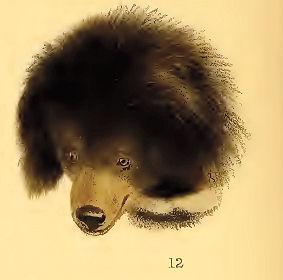
Abb.: Melursus ursinus Shaw, 1791
- Lippenbär - Sloth Bear =
[Bildquelle: Lydekker, Richard <1849 - 1915>: The great and small game of India, Burma, & Tibet. -- London, 1900. -- Pl. 9]
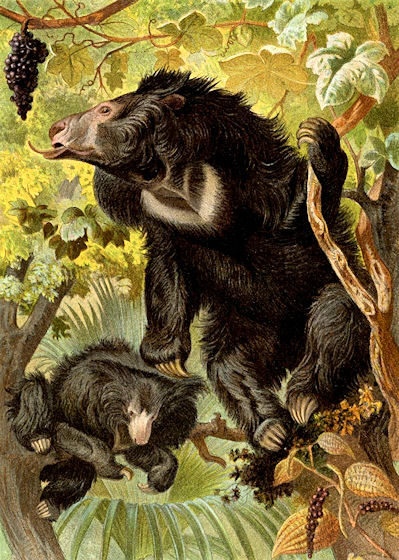
Abb.: Melursus ursinus Shaw, 1791
- Lippenbär - Sloth Bear =
Ursus ursinus (Shaw)
Krause et al., 2008
- Lippenbär - Sloth Bear
[Bildquelle: Brehms Tierleben, 1882 - 1887]
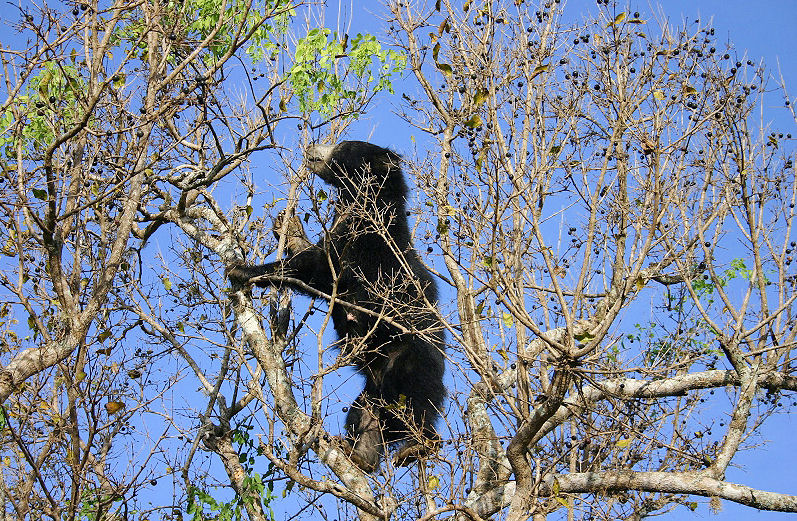
Abb.: Melursus ursinus Shaw, 1791
- Lippenbär - Sloth Bear =
Ursus ursinus (Shaw)
Krause et al., 2008
- Lippenbär - Sloth Bear, Yala
National Park -
[Bildquelle: Bodhita / Wikimedia. -- GNU FDLicense]
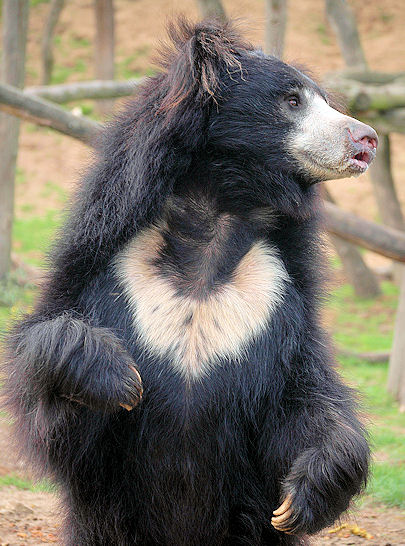
Abb.:
Melursus ursinus
Shaw, 1791
- Lippenbär - Sloth Bear =
Ursus ursinus (Shaw)
Krause et al., 2008
- Lippenbär - Sloth Bear, Zoo
[Bildquelle:
Marieke
IJsendoorn-Kuijpers. --
http://www.flickr.com/photos/mape_s/333862236/. -- Zugriff am 2010-12-09. --
Creative Commons
Lizenz (Namensnennung)]
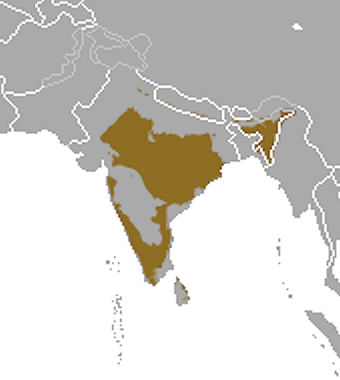
Abb.: Ungefährer heutiger Lebensraum des Lippenbären (Melursus ursinus Shaw,
1791
- Lippenbär - Sloth Bear =
Ursus ursinus (Shaw)
Krause et al., 2008
- Lippenbär - Sloth Bear)
[Bildquelle: Chermundy / IUCN Red List / Wikipedia. --
Creative Commons Lizenz
(Namensnennung, share alike)]
"This bear is found throughout India and Ceylon, from Cape Comorin to the Ganges, chiefly in the hilly and jungly districts. There never appear to be more than 4 incisors in the upper jaw. Bears are very abundant in some parts of the peninsula, where forest and jungle occur and the hills are rugged and rocky, and especially, as is the case in the Northern Circars, from Goomsoor southwards, and in various parts of Central India likewise, there are many hills formed of huge decomposed masses of granite simulating boulders (and indeed popularly called so), which have numberless natural caverns and recesses that suit these animals so well. They ascend the top of the Neelgherries and other high ranges of mountains in spring to feed, especially on the large larvae of a huge longicorn beetle, that issues from the ground in great numbers lateron; and which larvae the bear sucks out of the ground, having first found the spot and scraped away some of the top earth. Bears are at times dangerous when met in the woods, and in the Vindhian range of mountains, near Mhow, where they are very abundant, woodcutters are very often attacked by them without any provocation, and sadly mauled or killed. Tickell mentions the same occurrence in other parts of India, but attributes it to the bears having their cubs with them at the time. Mr. W. Elliot, in his Catalogue, says, "Their food seems to be black ants, termites, beetles, fruit, particularly the seeds of Cassia fistula, of the date tree, honey, &c. When pursued they carry their cubs on their backs. In 1833 a bear was chased and killed, having carried her two cubs in this way for nearly three miles. It appears to be a long-lived animal ; instances are known of their living in captivity for 40 years." Had Mr. Elliot lived in parts of Central India, he would have learned that there is no fruit* the Bear enjoys more than that of the Mohwa (Bassia latifolia), which falls in such profusion during the night, and the early sportsman is sure to find the bears engaged in their pleasant repast under some of these trees.
* It is properly only the sweet fleshy flower that falls off, not the fruit, as popularly called.
I have abridged from Tickell's admirable account of this animal the subsequent observations : "The power of suction in the bear as well as of propelling wind from its mouth is very great. It is by this means it is enabled to procure its common food of white ants and larvae with ease. On arriving at an ant-hill, the bear scrapes away with the fore-feet until he readies the large combs at the bottom of the galleries. He then with violent puffs dissipates the dust and crumbled particles of the nest, and sucks out the inhabitants of the comb by such forcible inhalations as to be heard at two hundred yards' distance or more. Large larvae are in this way sucked out from great depths under the soil. Where bears abound, their vicinity may be readily known by numbers of these uprooted ants' nests and excavations, in which the marks of their claws are plainly visible. They occasionally rob birds' nests and devour the eggs. In running the bear moves in a rough canter, shaking up and down, but gets with great speed over very bad ground, regardless of tumbles down the rough places. The sucking of the paw accompanied by a drumming noise when at rest, and especially after meals, is common to all bears, and during the heat of the day they may often be heard puffing and humming far down in caverns and fissures of rocks." The cause of this has often been speculated on, but Tickell imagines that it is merely a habit peculiar to it, and he states "that they are just as fond of sucking their neighbour's paws, or the hands of any person, as their own paws."
They go with young about seven months, and generally bring forth two, at various times, but most usually about December and January. When taken young they are capable of being most thoroughly tamed, and will then partake of any kind of food. They are very commonly led about to perform various antics. Their pursuit is a favourite sport among Europeans in India, and now and then a daring sportsman gets mauled severely by a wounded bear, whilst many others have had a narrow escape of a close embrace of their grisly foe. In the extreme south of India, among the Polygars of the hills, bears used to be hunted by strong fierce dogs, und when held at bay by them, the native sportsmen each thrust a long bamboo loaded with strong birdlime into the shaggy coat of their quarry, and thus firmly hold their struggling prey ; this practice I understand has of of late years almost fallen into disuse."
[Quelle: Jerdon, Thomas Claverhill <1811-1872>: The mammals of India : a natural history of all the animals known to inhabit continental India. -- London, 1874. -- S. 72ff.]
Ursus arctos isabellinus Horsfield, 1826 - Himalayabär - Himalayan Brown Bear
Subspecies des Braunbären.
Körperlänge: 245 cm
Gewicht:
Lebensraum: Himalaya, Jammu und Kashmir, Sikkim; 3000 bis 6000 m ü. M.
Noch in Freiheit lebende Individuen: ca. 300
Lebt als Einzelgänger
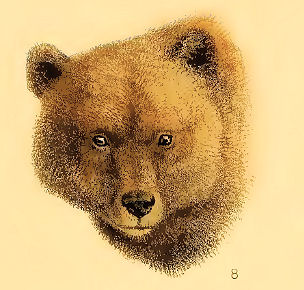
Abb.:
Ursus arctos isabellinus Horsfield, 1826 - Himalayabär - Himalayan Brown
Bear
[Bildquelle: Lydekker, Richard <1849 - 1915>: The great and small
game of India, Burma, & Tibet. -- London, 1900. -- Pl. 9]
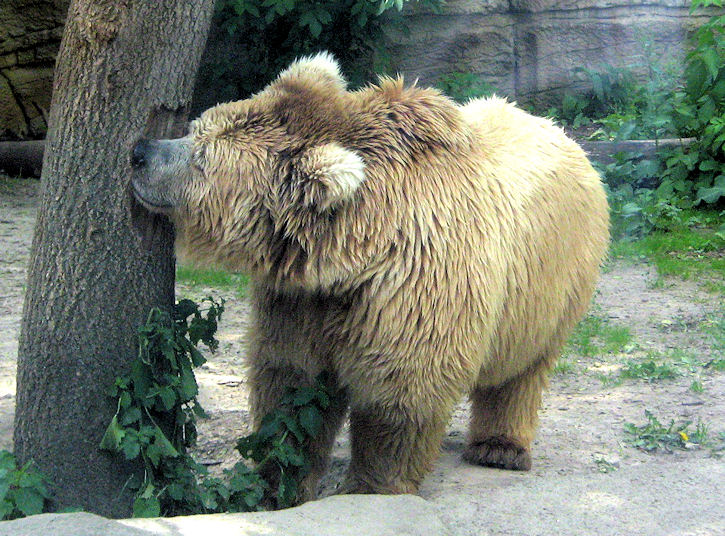
Abb.:
Ursus arctos isabellinus Horsfield, 1826 - Himalayabär - Himalayan Brown
Bear, Zoo
[Bildquelle: Doroshenkoe / Wikimedia. -- Public domain]

Abb.: Ungefährer heutiger Lebensraum des Braunbären (Ursus arctos
sp.)
[Bildquelle: Marlene / Wikipedia. -- Public domain]
"This fine bear belongs to restricted Ursus of some writers, being of the same type as the brown bear of Europe. The claws are less powerful than in the other groups, straight and obtuse. It is supposed by some to be identical with the Syrian bear. It is found only on the Himalayas, and at great elevations in summer, close to the snow. In autumn they descend lower, coming into the forests to feed on various fruit, seeds, acorns, hips of rose-bushes, &c., and often coming close to villages to plunder apples, walnuts, apricots, buck-wheat, &c. Their usual food in spring and summer is grass and roots. They also feed on various insects, and are seen turning over stones to look for scorpions (it is said) and insects that harbour in such places. In winter they retreat to caves, remaining in a state of semi- torpidity, issuing forth in March and April. Occasionally they are said to kill sheep or goats, often wantonly apparently, as they do not feed on them. They litter in April and May, the female having generally two cubs. If taken young, they are very easily domesticated. This bear does not climb trees well. They abound particularly in the N. W. Himalayas, and in the mountains round Kashmir. Many are killed every year by sportsmen." [Quelle: Jerdon, Thomas Claverhill <1811-1872>: The mammals of India : a natural history of all the animals known to inhabit continental India. -- London, 1874. -- S. 70.]
Ursus thibetanus G. Cuvier, 1823 - Kragenbär - Asian Black Bear
Körperlänge: 140 - 170 cm
Gewicht: 90 - 115 kg
Lebensraum: Himalaya von Jammu und Kashmir bis Arunachal Pradesh, Berge
Nordostindiens; 1200 - 3000 m ü. M. Überwintert im Himalaya.
Noch in Freiheit lebende Individuen: 3.000
Lebt als Einzelgänger
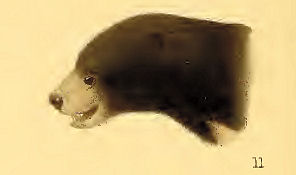
Abb.: Ursus thibetanus G. Cuvier, 1823 - Kragenbär - Asian Black Bear
[Bildquelle: Lydekker, Richard <1849 - 1915>: The great and small
game of India, Burma, & Tibet. -- London, 1900. -- Pl. 9]
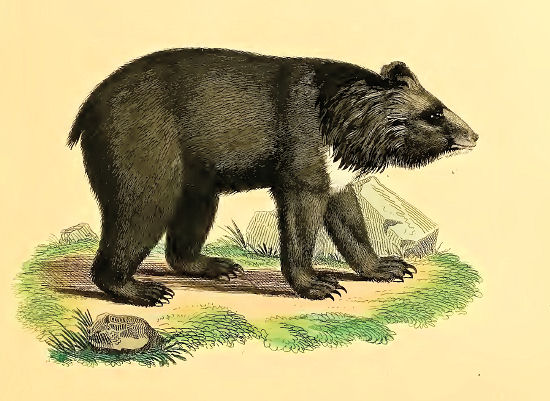
Abb.: Ursus thibetanus G. Cuvier, 1823 - Kragenbär - Asian Black Bear
[Bildquelle: Die Säugthiere in Abbildungen nach der Natur, mit
Beschreibungen von Johann Christian Daniel von Schreber ... Fortgesetzt von d.
August Goldfuss ..., 1797 - 1861. -- Tafel CXLI.D]
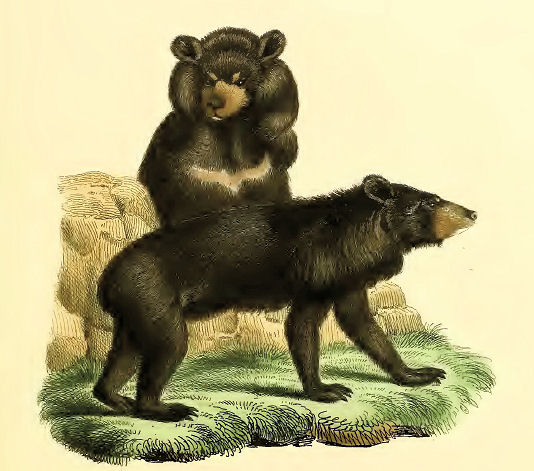
Abb.: Ursus thibetanus G. Cuvier, 1823 - Kragenbär - Asian Black Bear
[Bildquelle: Die Säugthiere in Abbildungen nach der Natur, mit
Beschreibungen von Johann Christian Daniel von Schreber ... Fortgesetzt von d.
August Goldfuss ..., 1797 - 1861. -- Tafel CXLI.DD]
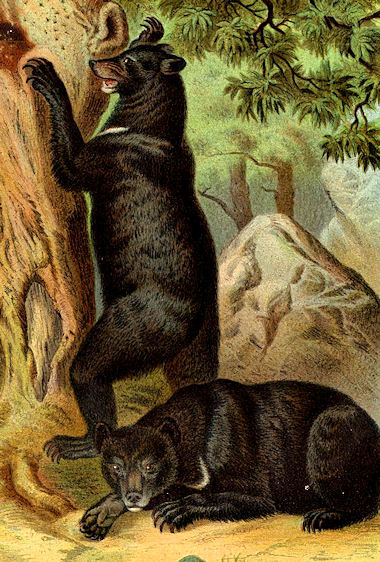
Abb.: Ursus thibetanus G. Cuvier, 1823 - Kragenbär - Asian Black Bear
[Bildquelle: Brehms Tierleben, 1882 - 1887]
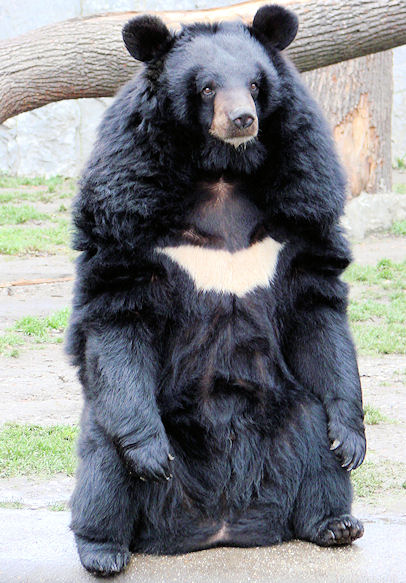
Abb.: Ursus thibetanus G. Cuvier, 1823 - Kragenbär - Asian Black Bear, Zoo
[Bildquelle: Guérin Nicolas / Wikimedia. -- GNU FDLicense]
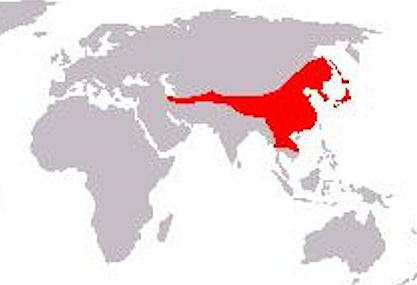
Abb.: Ungefährer heutiger Lebensraum des Kragenbären (Ursus
thibetanus Cuvier 1823)
[Bildquelle: Jürgen / Wikipedia. -- GNU FDLicense]
"This bear is only found, within our province, on the Himalayas, but it is also found in the hill-ranges at Assam. Its specific name is unfortunate, since it is rare in Thibet. In summer it is generally found at a considerable elevation, 9 to 12,000 feet or so, and often close to snow; but in winter it descends to 5,000 feet, and even lower sometimes. It lives chiefly on fruits and roots, apricots, walnuts, apples, currants, &c., also on various grains, barley, Indian corn, buck-wheat, &c. ; and in winter chiefly feeds on various acorns, climbing the oak-trees and breaking down the branches ; and it is not uncommon to find one early in the morning in an oak-tree, close to some dwelling-house or village. Occasionally, when urged by hunger, they will destroy the crops of barley, buck-wheat, &c., in broad daylight, also the cucumbers and pumpkins planted close to the villages, and trailing over the huts. They are very fond of honey, and occasionally pull down the honey from the hives kept by the hill people, and built into their huts. Now and then they will kill sheep, goats, &c., and are said occasionally to eat flesh. They often visit the village mill, licking up the remnants of flour. During the daytime they take shelter in the interior of some decayed tree, or among rocks, occasionally in some thick clump of trees. The female brings forth her young, generally two in number, in some den or cave among rocks.
This bear has bad eyesight, but great power of smell, and if approached from windward is sure to take alarm. A wounded bear will sometimes show fight, but in general it tries to escape. It is said sometimes to coil itself into the form of a ball, and thus roll down steep hills, if frightened or wounded. If met suddenly where there is no means of escape, it will attack man at once ; and, curious to say, it always mauls the face, some times taking off most of the hairy scalp and frightfully disfiguring the unfortunate sufferer. There are few villages in the interior, where one or more individuals thus mutilated are not to be be met with. It has been noticed that if caught in a noose or snare, if they cannot break it by force, they never have the intelligence to bite the rope in two, but remain till they die or are killed. In captivity this bear, if taken young, is very quiet and playful, but is not so docile as the next species. Like others of its kind, it is fond of sucking its own or its neighbour's paws."
[Quelle: Jerdon, Thomas Claverhill <1811-1872>: The mammals of India : a natural history of all the animals known to inhabit continental India. -- London, 1874. -- S. 71.]
Helarctos malayanus Raffles, 1821- Malaienbär - (Malayan) Sun Bear
Körperlänge: 104 - 140 cm
Gewicht: 27 - 65 kg
Lebensraum: Subtropische Wälder südlich des Brahmaputra in Assam, Arunachal
Pradesh, Mizoram, Manipur
Noch in Freiheit lebende Individuen: unbekannt
Lebt als Einzelgänger
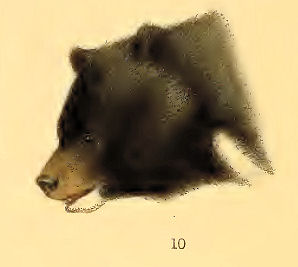
Abb.:
Helarctos malayanus Raffles, 1821- Malaienbär - (Malayan) Sun Bear
[Bildquelle: Lydekker, Richard <1849 - 1915>: The great and small
game of India, Burma, & Tibet. -- London, 1900. -- Pl. 9]
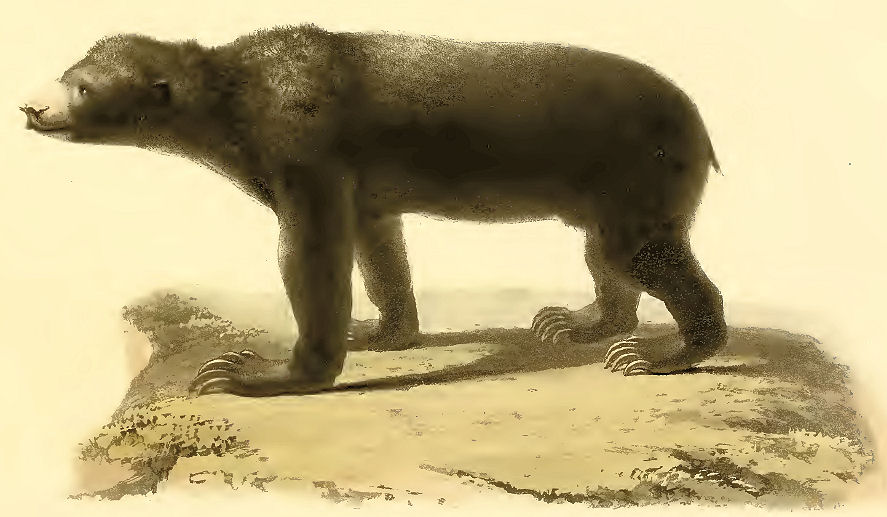
Abb.:
Helarctos malayanus Raffles, 1821- Malaienbär - (Malayan) Sun Bear
[Bildquelle: Horsfield, Thomas: Zoological researches in Java, and the
neighbouring islands, 1824]
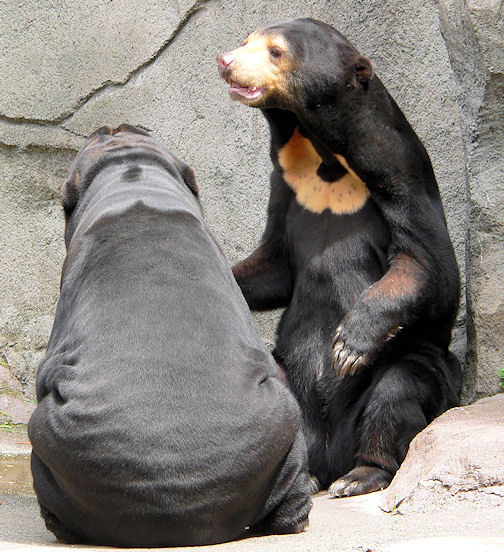
Abb.:
Helarctos malayanus Raffles, 1821- Malaienbär - (Malayan) Sun Bear,
Zoo
[Bildquelle: Frank C. Müller / Wikimedia. --
Creative Commons
Lizenz (Namensnennung, share alike)]
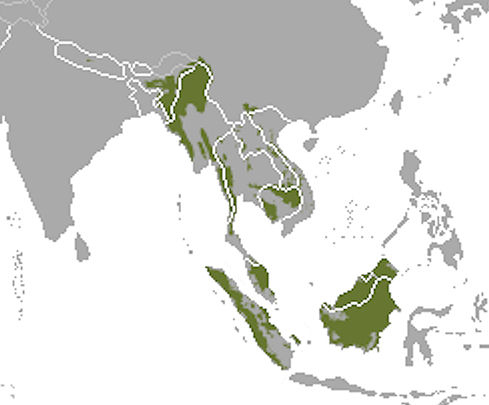
Abb.: Heutiger Lebensraum von
Helarctos malayanus Raffles, 1821- Malaienbär - (Malayan) Sun Bear
[Bildquelle: Chermundy & IUCN. --
Creative Commons
Lizenz (Namensnennung, share alike)]
Erläuterungen:
Siehe:
Carakasaṃhitā: Ausgewählte Texte aus der Carakasaṃhitā / übersetzt und erläutert von Alois Payer <1944 - >. -- Anhang B: Tierbeschreibungen. -- Ursus arctos isabellinus. -- URL: http://www.payer.de/ayurveda/tiere/ursus_arctos_isabellinus.htm
Carakasaṃhitā: Ausgewählte Texte aus der Carakasaṃhitā / übersetzt und erläutert von Alois Payer <1944 - >. -- Anhang B: Tierbeschreibungen. -- Ursus thibetanus. -- http://www.payer.de/ayurveda/tiere/ursus_thibetanus.htm
Carakasaṃhitā: Ausgewählte Texte aus der Carakasaṃhitā / übersetzt und erläutert von Alois Payer <1944 - >. -- Anhang B: Tierbeschreibungen. -- Melursus ursinus. -- URL: http://www.payer.de/ayurveda/tiere/melursus_ursinus.htm
2.9.7. Nashörner
| 4. a./b.
ṛkṣācchabhallabhallūkā gaṇḍake khaḍgakhaḍginau ऋक्षाच्छ-भल्ल-भल्लूका गण्डके खड्ग-खड्गिनौ ।४ क। Bezeichnungen für गण्डक - gaṇḍaka m.: Nashorn (zu gaṇda m: Wange, Beule, Kropf):
|
Colebrooke (1807): "A rhinoceros."
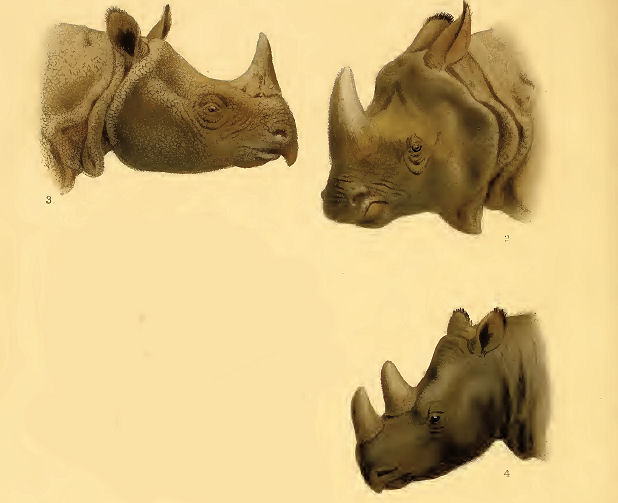
Abb.:
खड्गिनः ।
2. Rhinoceros unicornis Linnaeus, 1758 - Panzernashorn - Indian Rhinozeros ;
3. Rhinoceros sondaicus Desmarest 1822 - Java-Nashorn - Javan Rhinoceros ;
4. Dicerorhinus sumatrensis Fischer, 1814 - Sumatranashorn - Sumatran Rhinoceros[Bildquelle: Lydekker, Richard <1849 - 1915>: The great and small game of India, Burma, & Tibet. -- London, 1900. -- Pl. 1]
In Indien kommen bzw. kamen folgende Arten von Nashörnern vor:
- Rhinoceros unicornis Linnaeus, 1758 - Panzernashorn - Indian Rhinoceros (früher auch in Nordpakistan, Großteil Nordindiens, Nepal, Nord-Bangladesh, Assam)
- Rhinoceros sondaicus Desmarest, 1822 - Java-Nashorn - Javan Rhinoceros (bis vor ca. 150 Jahren auch in Ostindien und Bangladesh)
- Dicerorhinus sumatrensis G. Fischer, 1814 - Sumatranashorn - Sumatran Rhinoceros (früher auch Assam, Südost-Bangladesh)
Rhinoceros unicornis Linnaeus, 1758 - Panzernashorn - Indian Rhinoceros
Heute einzige Nashornart Indiens.
Schulterhöhe: 170 - 185 cm
Gewicht: 1500 - 2100 kg
Lebensraum: früher Nordindien, heute einzelne Refugien im Norden von West Bengal,
Assam
Noch in Freiheit lebende Individuen: ca. 1750
Lebt als Einzelgänger, auch paarweise oder in Gruppen
Folgt immer denselben Pfaden, deswegen eine leichte Beute für Wilderer.
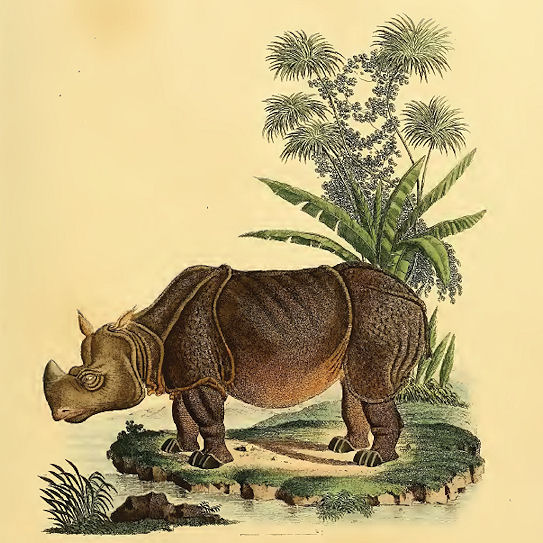
Abb.:
Rhinoceros unicornis Linnaeus, 1758 - Panzernashorn
- Indian Rhinoceros
[Bildquelle: Die Säugthiere in Abbildungen nach der Natur,
mit Beschreibungen von Johann Christian Daniel von Schreber ... Fortgesetzt von
d. August Goldfuss ..., 1797 - 1861. -- Tafel LXXVII]
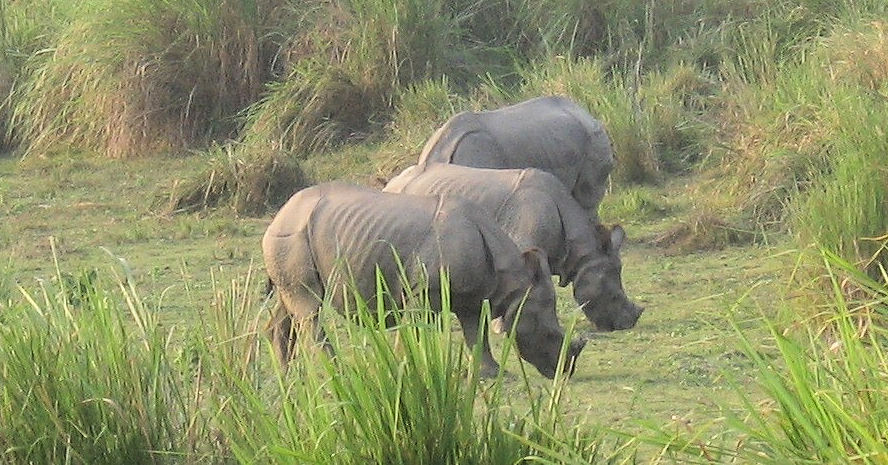
Abb.:
Rhinoceros unicornis Linnaeus, 1758 - Panzernashorn
- Indian Rhinoceros,
Kaziranga National Park -
কাজিৰঙা
ৰাষ্ট্ৰীয় উদ্যান, Assam
[Bildquelle: Deepraj / Wikimedia. -- GNU FDLicense]
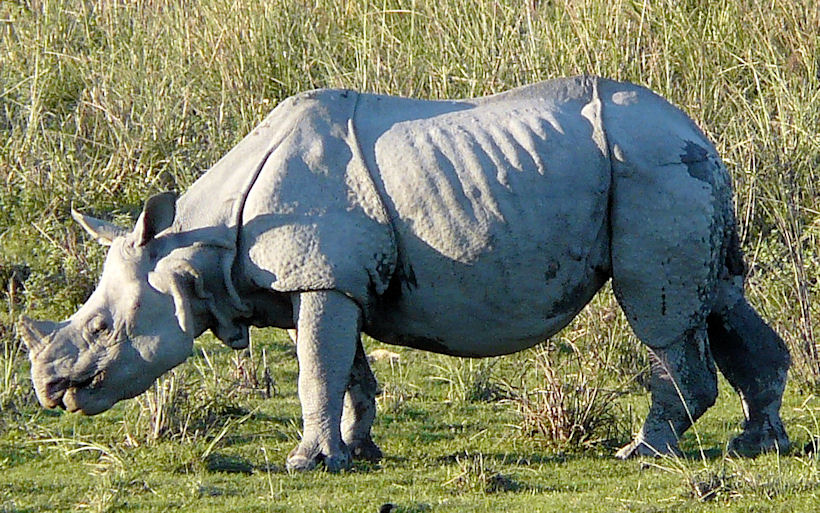
Abb.:
Rhinoceros unicornis Linnaeus, 1758 - Panzernashorn
- Indian Rhinoceros,
Kaziranga National Park -
কাজিৰঙা
ৰাষ্ট্ৰীয় উদ্যান, Assam
[Bildquelle: Rita Willaert. --
http://www.flickr.com/photos/rietje/2243943154/. -- Zugriff am 2010-12-09.
-- Creative
Commons Lizenz (Namensnennung, keine kommerzielle Nutzung)]
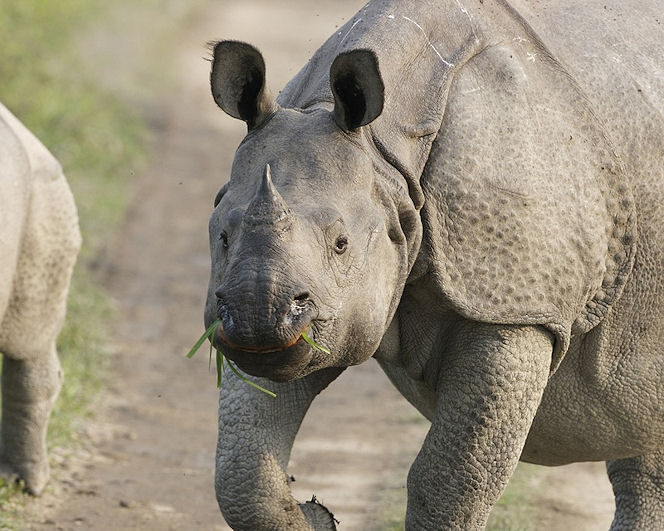
Abb.:
Rhinoceros unicornis Linnaeus, 1758 - Panzernashorn
- Indian Rhinoceros,
Kaziranga National Park -
কাজিৰঙা
ৰাষ্ট্ৰীয় উদ্যান, Assam
[Bildquelle: Lip Kee. --
http://www.flickr.com/photos/lipkee/2442759707/. -- Zugriff am 2010-12-09.
-- Creative Commons
Lizenz (Namensnennung, keine kommerzielle Nutzung)]
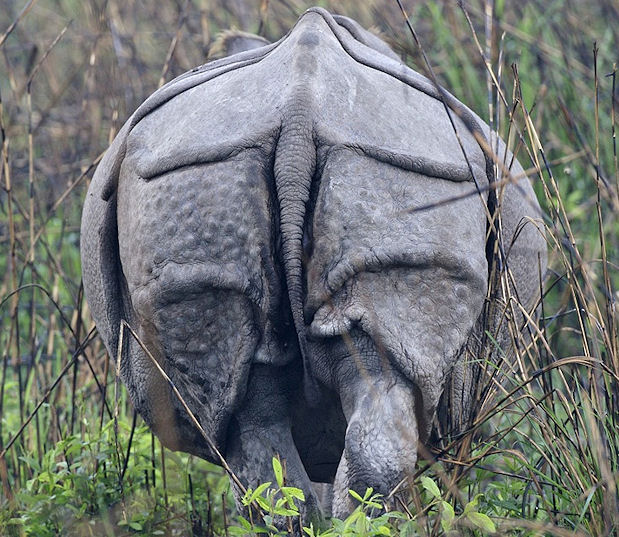
Abb.:
Rhinoceros unicornis Linnaeus, 1758 - Panzernashorn
- Indian Rhinoceros,
Kaziranga National Park -
কাজিৰঙা
ৰাষ্ট্ৰীয় উদ্যান, Assam
[Bildquelle: Lip Kee. --
http://www.flickr.com/photos/lipkee/2501389422/. -- Zugriff am 2010-12-09.
-- Creative Commons
Lizenz (Namensnennung, keine kommerzielle Nutzung)]
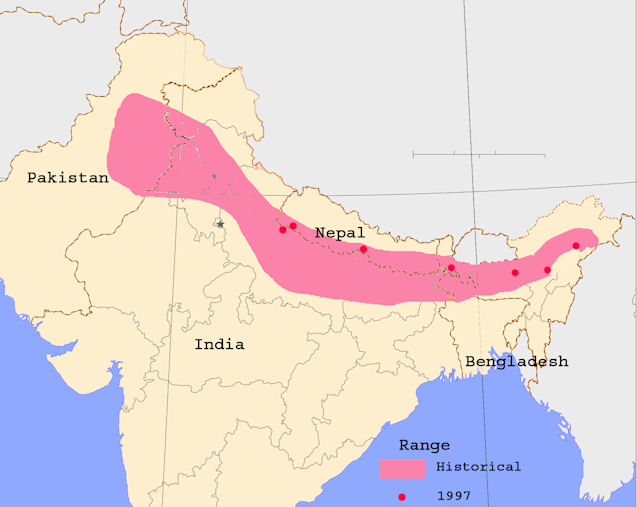
Abb.: Ursprünglicher und heutiger Lebensraum von
Rhinoceros unicornis - Panzernashorn
[Bildquelle: Christophe cagé / Wikipedia. -- GNU FDLicense]
"This huge rhinoceros is found in the Terai at the foot of the Himalayas, from Bhotan to Nepal. It is more common in the eastern portion of the Terai than the west, and is most abundant in Assam and the Bhotan Dooars. I have heard from sportsmen of its occurrence as far west as Rohilcund, but it is certainly rare there now, and indeed along the greater part of the Nepal Terai ; and although a few have been killed in the Sikim Terai, they are more abundant east of the Teesta river. As far as is at present known, this species does not extend to the south of the region adjoining the Himalayas, though it is possible that it may cross the Berrampooter river, and occur on the north of the range of hills that bound that valley to the south.
It frequents swampy ground in the forests, and dense jungles. The Rhinoceros is almost always hunted for on elephants, and a wounded one will occasionally charge and overthrow an elephant. The very thick hide of this animal requires a hard ball, and a steel-tipped bullet was frequently used before the introduction of the deadly shell, now in general use against large game. Jelpigoree, a small military station near the Teesta River, was a favourite locality whence to hunt the Rhinoceros and it was from that station Captain Fortescue, of the late 73rd N.I., got his skulls, which were, strange to say, the first that Mr. Blyth had seen of this species, of which there were no specimens in the Museum of the Asiatic Society at the time when he wrote his Memoir on this group."
[Quelle: Jerdon, Thomas Claverhill <1811-1872>: The mammals of India : a natural history of all the animals known to inhabit continental India. -- London, 1874. -- S. 233f.]
Rhinoceros sondaicus Desmarest, 1822 - Java-Nashorn - Javan Rhinoceros
Schulterhöhe: 170 cm
Gewicht: 1800 kg
Lebensraum: bis vor ca. 150 Jahren auch in Ostindien und Bangladesh
Noch in Freiheit lebende Individuen: in Indien ausgerottet
Lebt als Einzelgänger
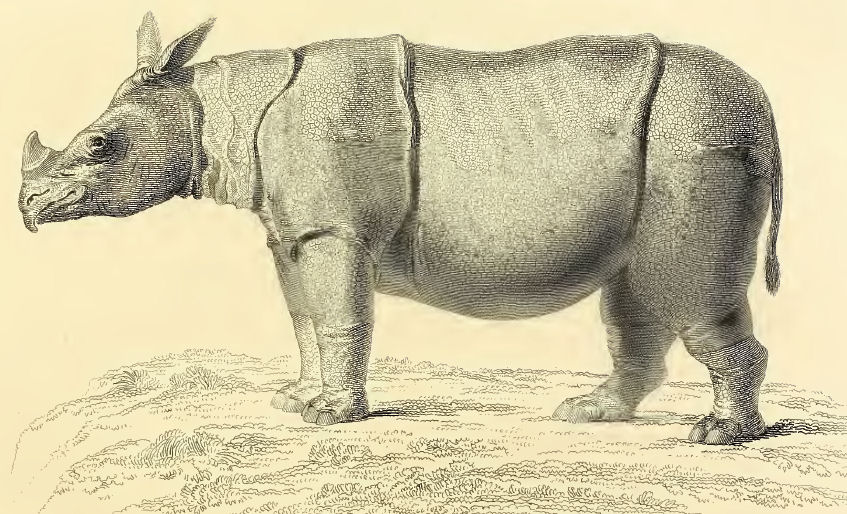
Abb.: Rhinoceros sondaicus Desmarest 1822- Java-Nashorn - Javan
Rhinoceros
[Bildquelle: Horsfield, Thomas: Zoological researches in Java, and the
neighbouring islands, 1824]
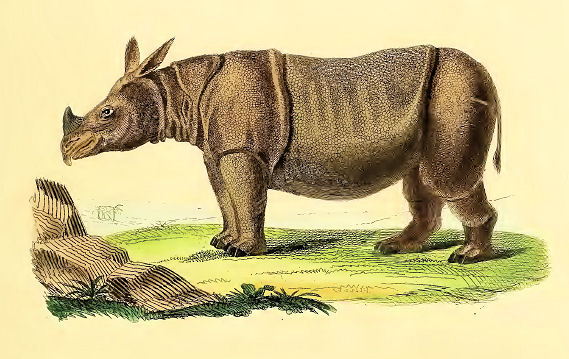
Abb.: Rhinoceros sondaicus Desmarest 1822- Java-Nashorn - Javan
Rhinoceros
[Bildquelle: Die Säugthiere in Abbildungen nach der Natur, mit
Beschreibungen von Johann Christian Daniel von Schreber ... Fortgesetzt von d.
August Goldfuss ..., 1797 - 1861. -- Tafel CCCXVII.E]
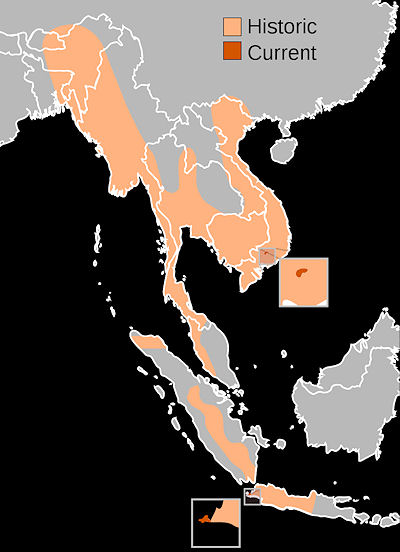
Abb.: Früherer und heutiger Lebensraum von Rhinoceros sondaicus Desmarest
1822- Java-Nashorn - Javan Rhinoceros
[Bildquelle: JayHenry / Wikipedia. -- Public domain]
"The Lesser Rhinoceros is found at present in the Bengal Sunderbuns, and a very few individuals are stated to occur in the forest tract along the Mahanuddy river, and extending northwards towards Midnapore ; and also on the northern edge of the Rajmahal hills near the Ganges. It occurs also more abundantly in Burmah, and thence through the Malayan peninsula to Java and Borneo. Several have been killed quite recently within a few miles of Calcutta.
One of these species formerly existed on the banks of the Indus, where it was hunted by the Emperor Baber. Individuals of this species are not unfrequently taken about the country as a show."
[Quelle: Jerdon, Thomas Claverhill <1811-1872>: The mammals of India : a natural history of all the animals known to inhabit continental India. -- London, 1874. -- S. 234.]
Dicerorhinus sumatrensis G. Fischer, 1814 - Sumatranashorn - Sumatran Rhinoceros
Schulterhöhe: 130 cm
Gewicht: 500 - 800 kg
Lebensraum:
früher auch Assam, Südost-Bangladesh
Noch in Freiheit lebende Individuen: in Indien ausgerottet
Lebt als Einzelgänger
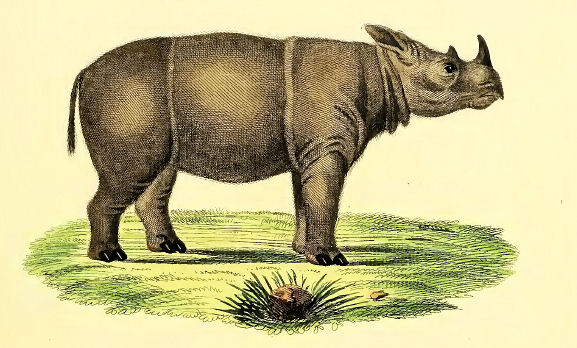
Dicerorhinus sumatrensis Fischer, 1814 - Sumatranashorn
- Sumatran Rhinoceros
[Bildquelle: Die Säugthiere in Abbildungen nach der Natur,
mit Beschreibungen von Johann Christian Daniel von Schreber ... Fortgesetzt von
d. August Goldfuss ..., 1797 - 1861. -- Tafel CCCXVII.G]
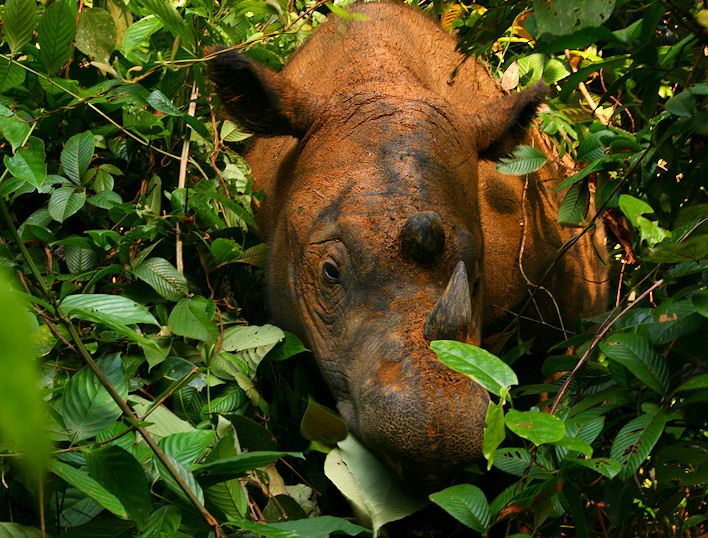
Dicerorhinus sumatrensis Fischer, 1814 - Sumatranashorn
- Sumatran Rhinoceros, Way Kambas, Sumatra, Indonesien
[Bildquelle: Willem v. Strien. --
http://www.flickr.com/photos/21150935@N07/3244891359. -- Zugriff am
2010-12-09. --
Creative Commons Lizenz (Namensnennung)]
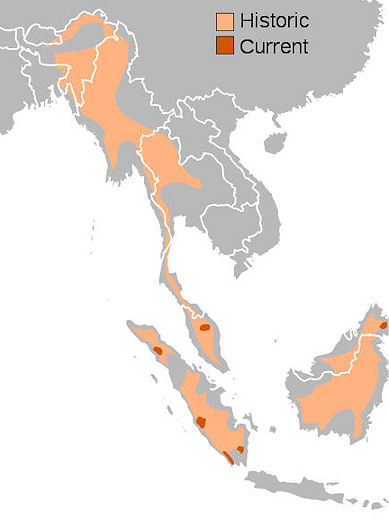
Abb.: Vergangene und gegenwärtige Verbreitung von Dicerorhinus sumatrensis Fischer, 1814
- Sumatranashorn
[Bildquelle: JayHenry / Wikipedia. -- Public domain]
"The only other Asiatic rhinoceros is the two-horned one, Rhinoceros sumatranus, which has been shot as high as north latitude 23° or so, near Sandoway, and is suspected by Blyth to extend as far north as Assam. Though with two horns, it is quite of the same type as the one-horned species, having strong incisors, and not like the African two-horned species, which have deciduous incisors. It is the most common rhinoceros in the Indo-Chinese territories, extending to Sumatra only among the islands."
[Quelle: Jerdon, Thomas Claverhill <1811-1872>: The mammals of India : a natural history of all the animals known to inhabit continental India. -- London, 1874. -- S. 234f.]
Erläuterungen:
Siehe:
Carakasaṃhitā: Ausgewählte Texte aus der Carakasaṃhitā / übersetzt und erläutert von Alois Payer <1944 - >. -- Anhang B: Tierbeschreibungen. -- Rhinocerotidae. -- URL: http://www.payer.de/ayurveda/tiere/rhinocerotidae.htm
Zu siṃhādivargaḥ. -- 2. Vers 4c - 12b (Säugetiere II und Warane)

